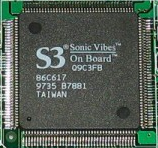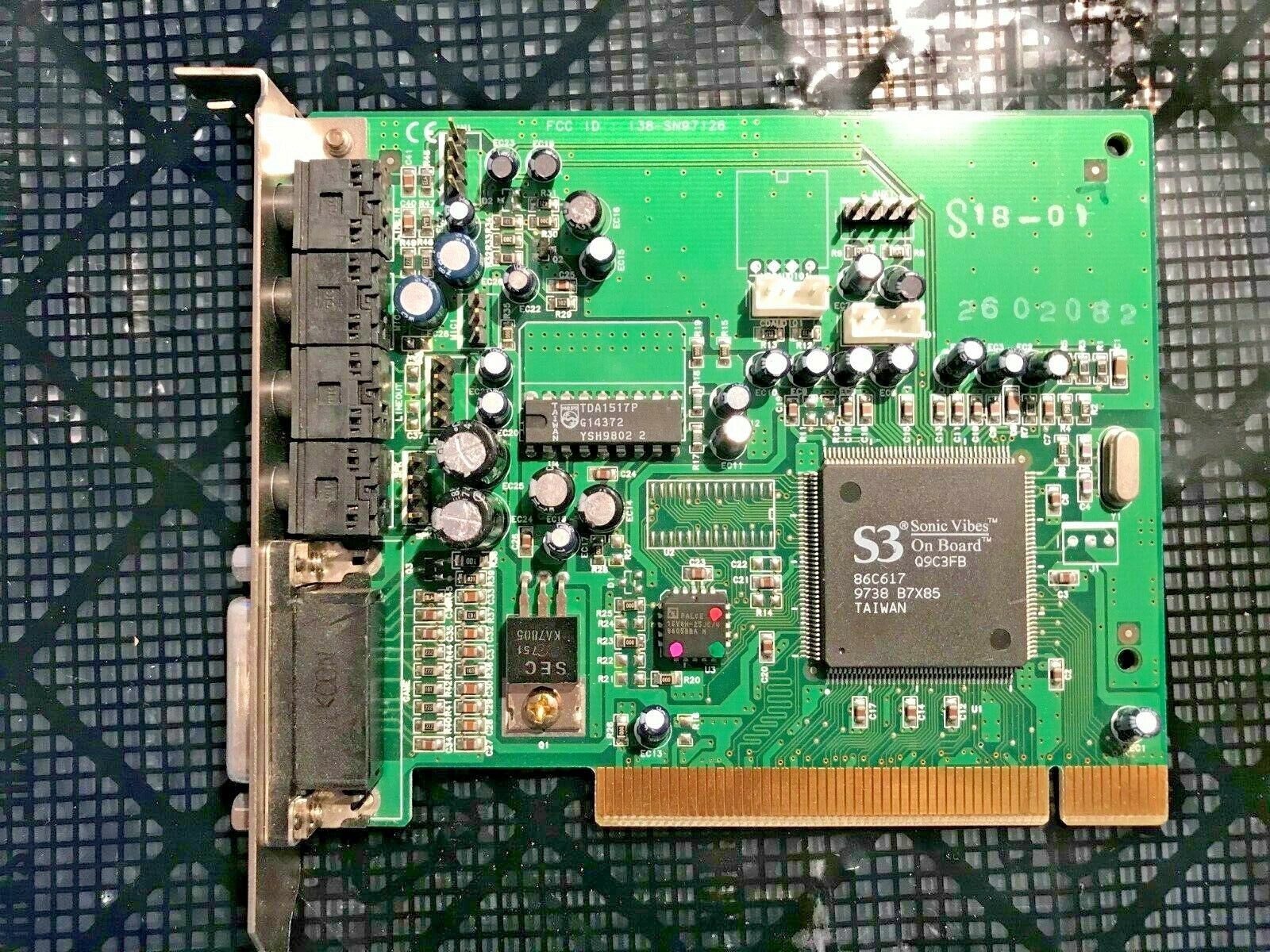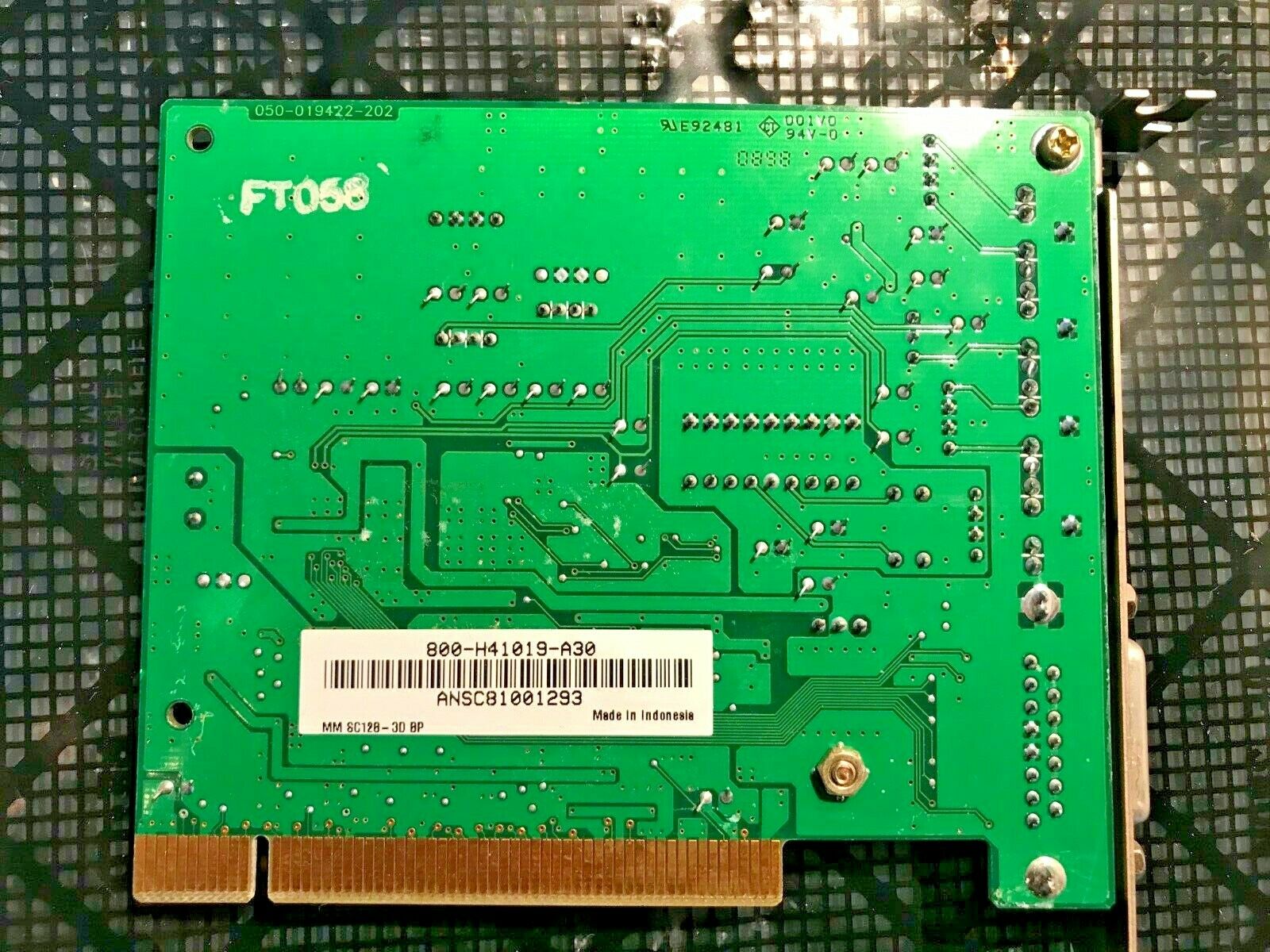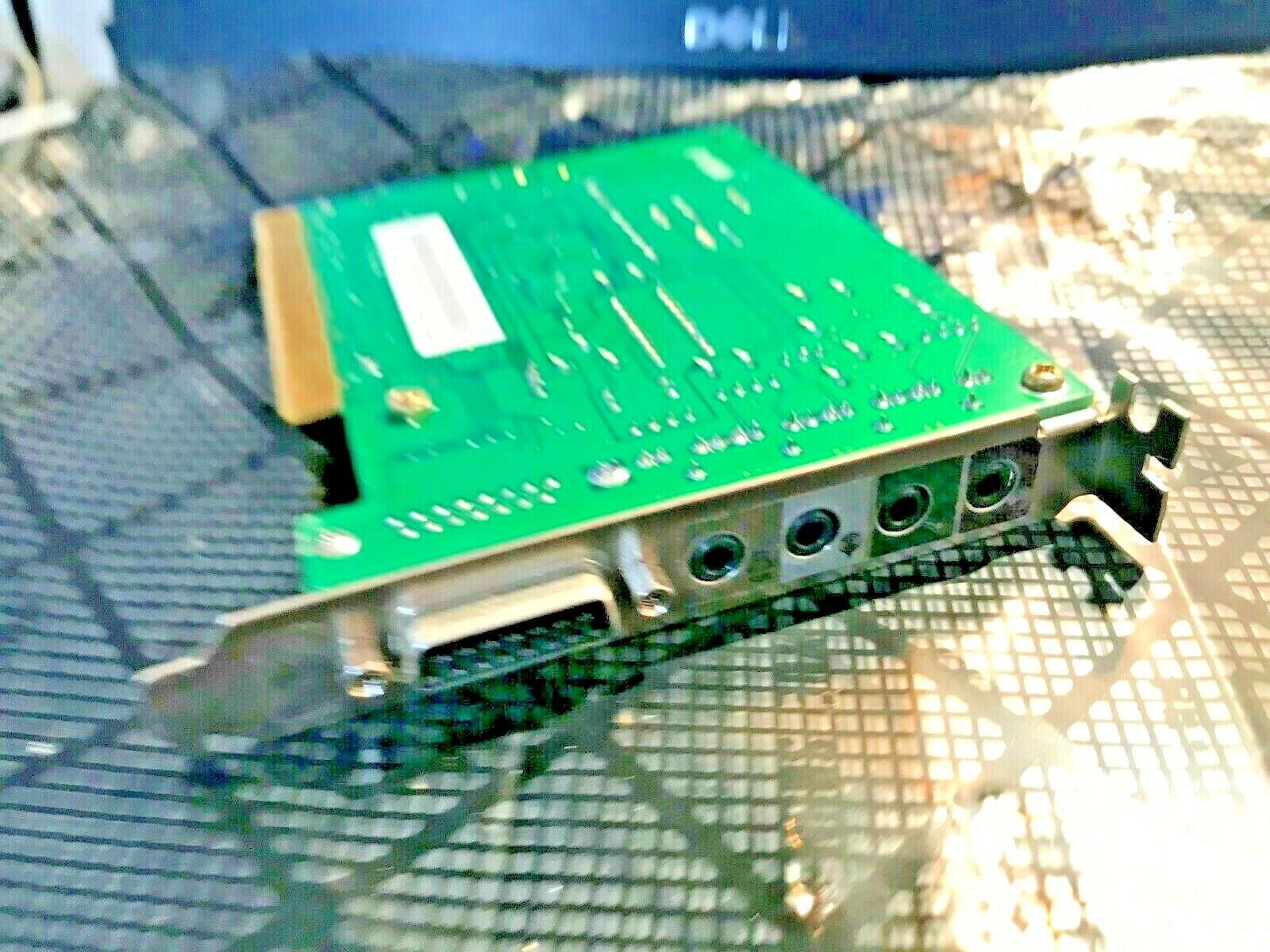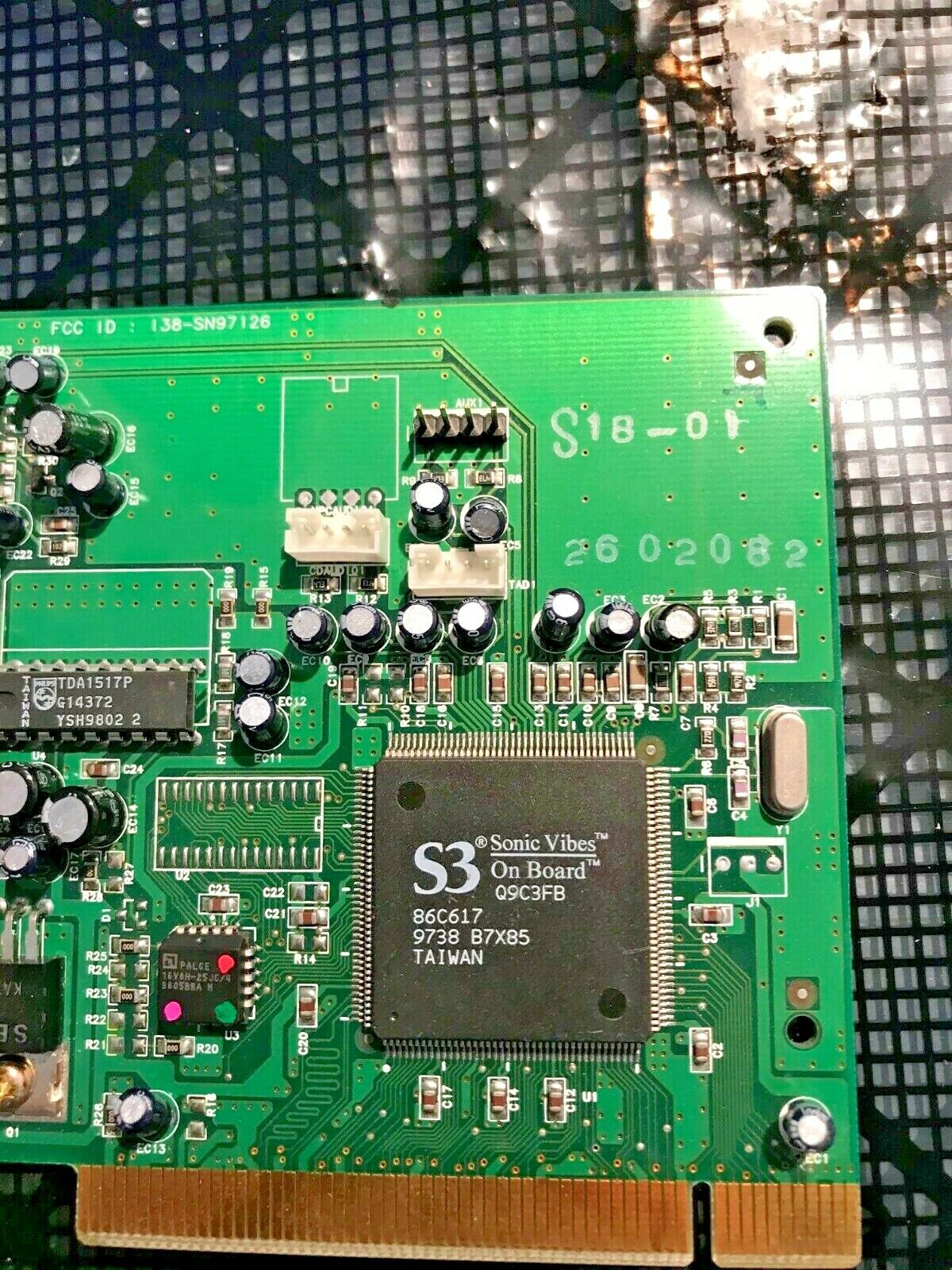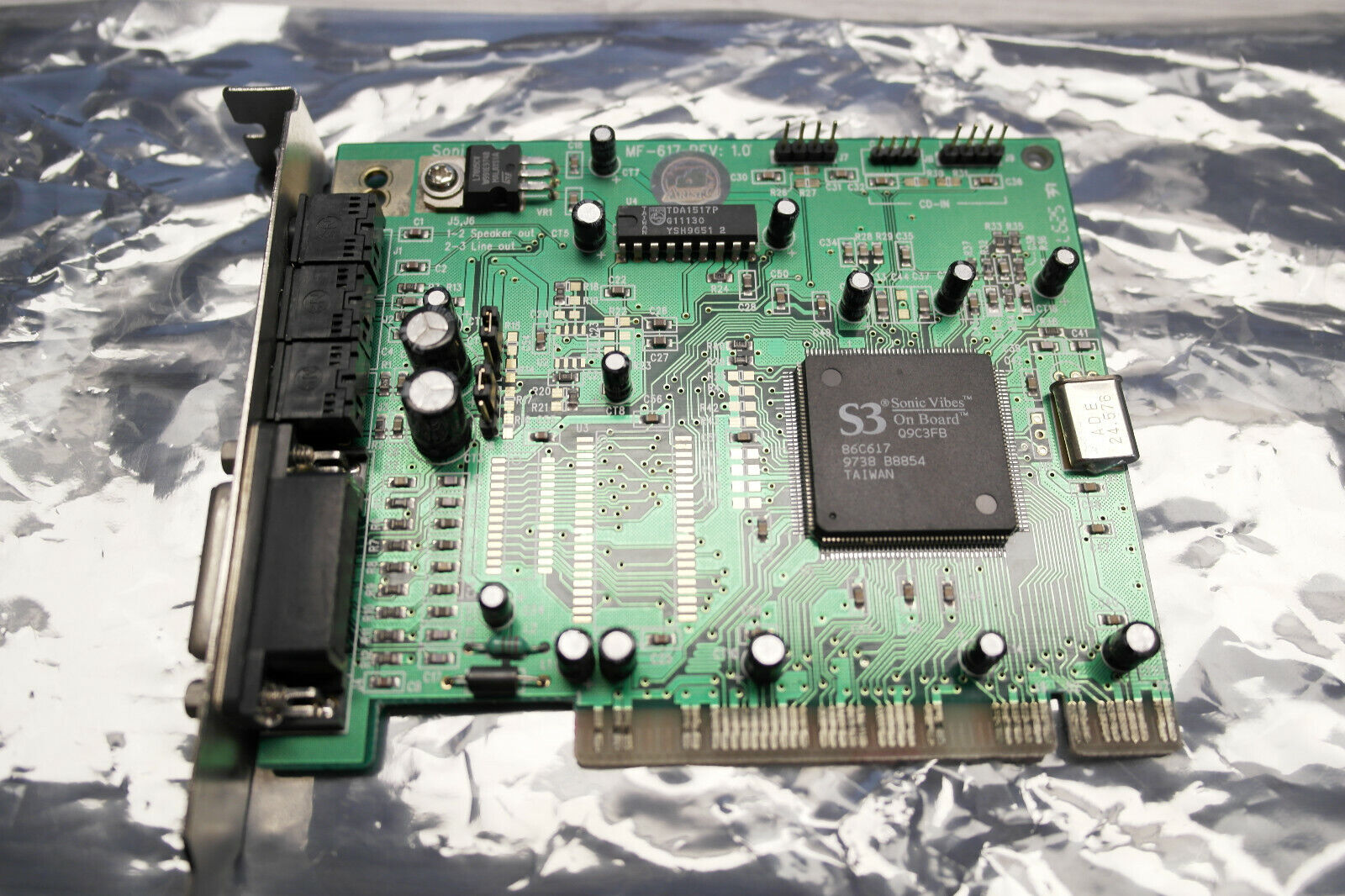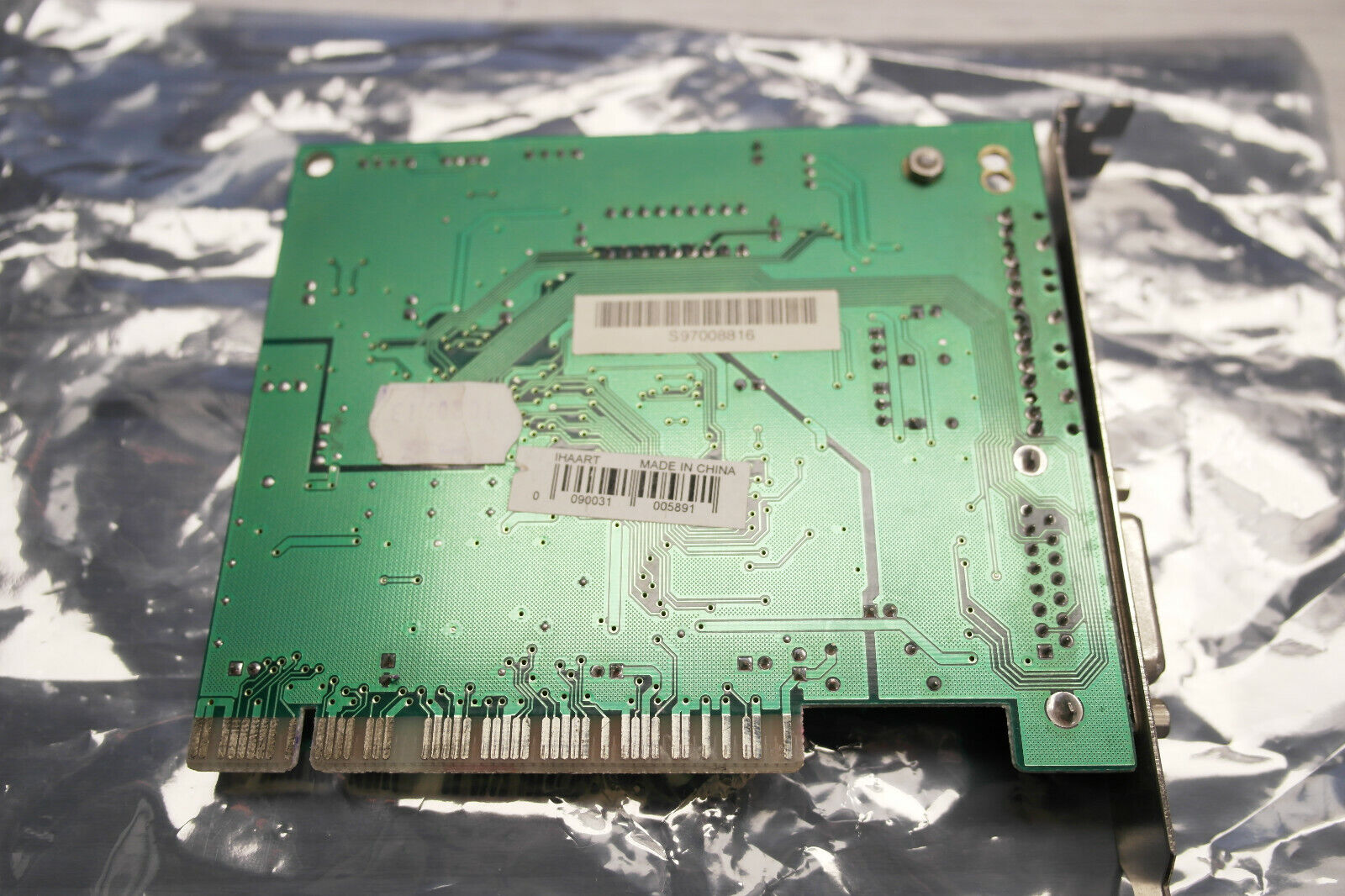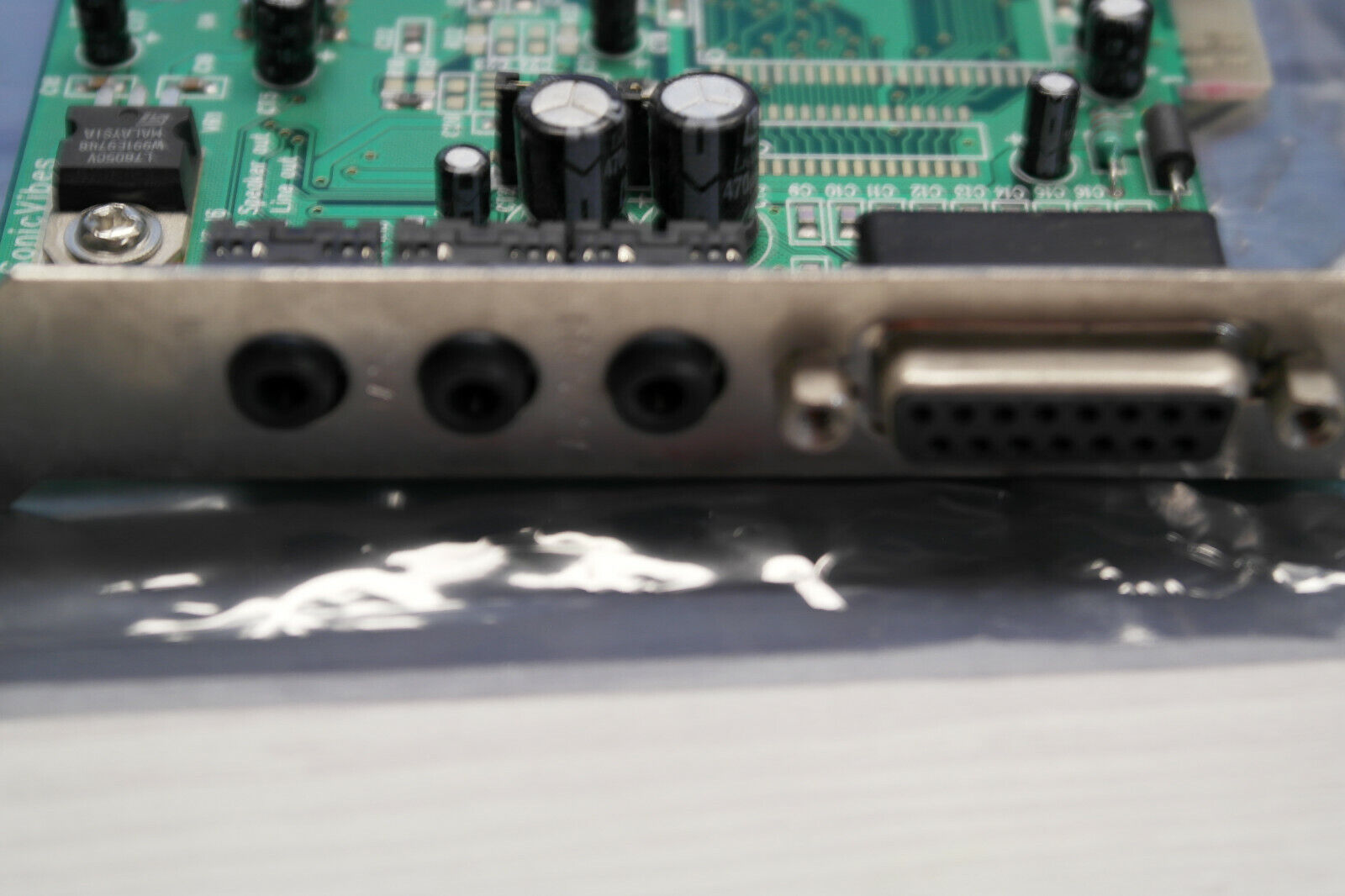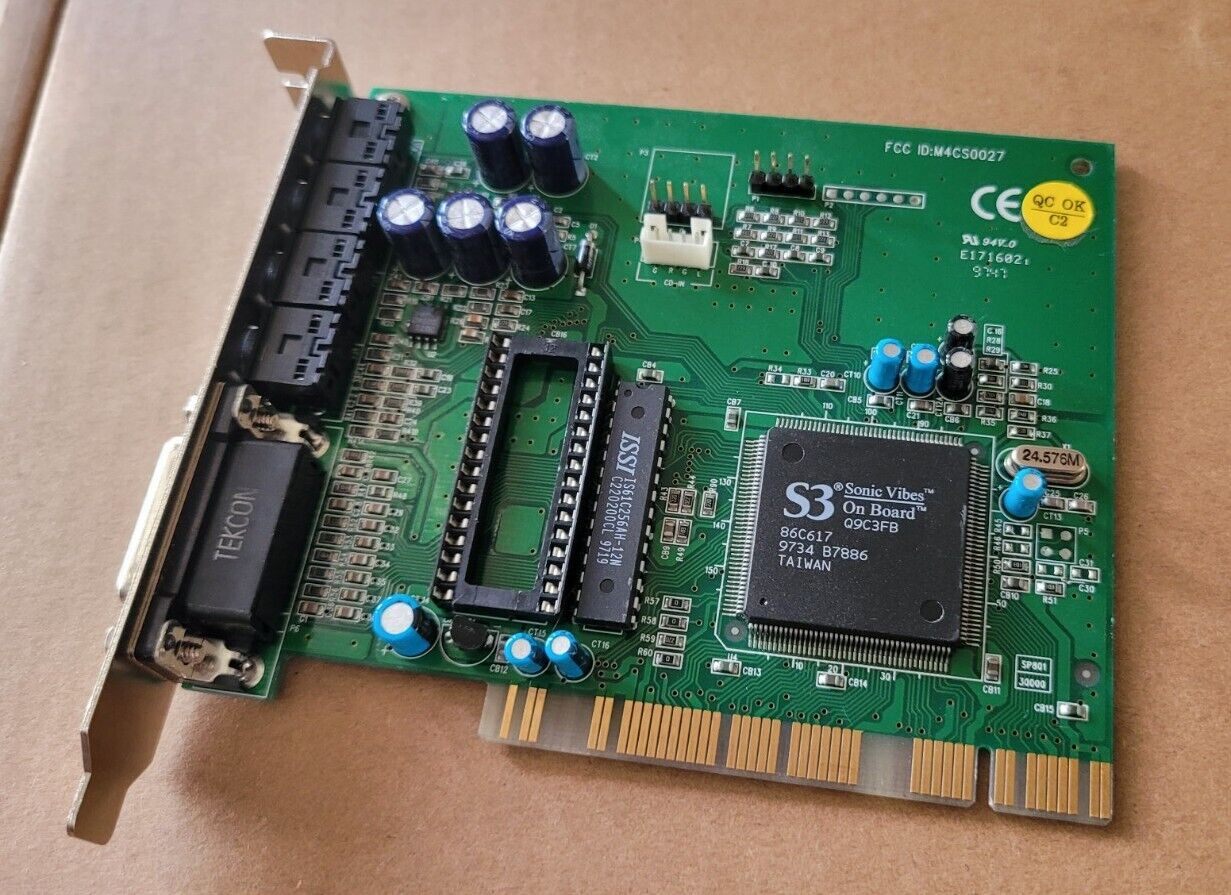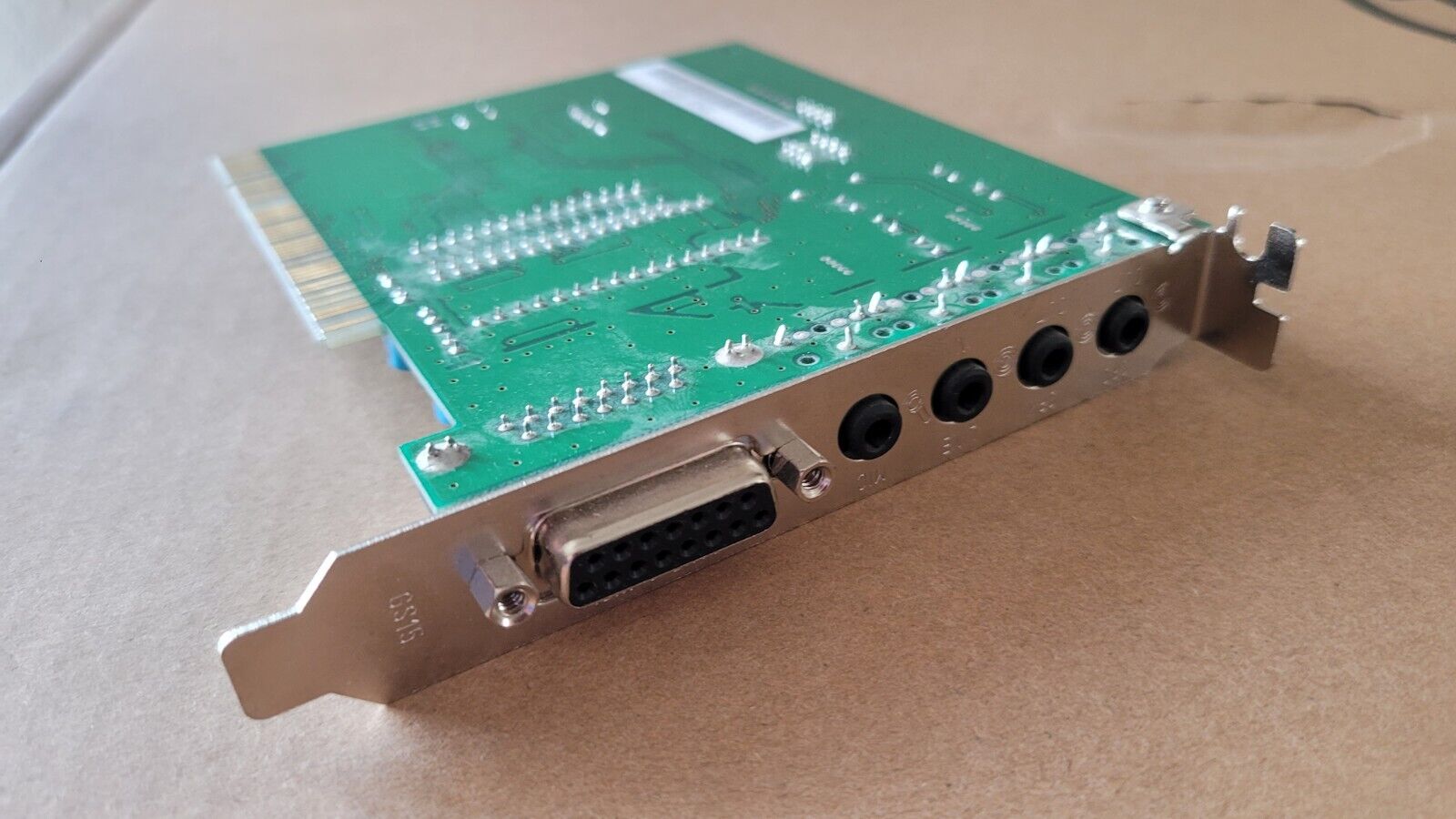S3 was one of the manufacturers of graphics cards for the IBM PC and its compatibles during the 1990s. They also produced a single audio chipset, called Sonic Vibes.
Its popular ViRGE (Virtual Reality Graphics Engine) chipset, launched in 1995, was one of the first 2D/3D accelerators designed for the consumer market, and it was the first to integrate it all into a single chip.
What started out to be very promising turned into disaster, with the company falling from top spot in 1996 to being run out of town by competitors within just 3 years. Their 3D engine continued long after with the Trio line, but despite their bad form and possibly in a last attempt to turn their fortunes around, they acquired Diamond Multimedia in 1999.
These days S3's cards have a poor reputation, and aren't a popular pick for retro gamers. This is partly due to the often buggy driver software in Windows. For DOS use, S3 cards prior to Savage had a great level of compatibility.
S3's numbering system was a little confusing and not exactly chronological, and some are named after Porsche model numbers and names. They started with the 911, then the 924. The first Windows accelerators then followed with 801 and 805. The 928 was then released to replace the 924. These were all succeeded by the "Vision" range which comprised 864, 868, 964 and 968. After all of these S3 entered the "Trio" era, then "ViRGE", and finally "Savage".
 911 911
Launched: 1991
Bus: ISA 16-bit, VESA Local Bus
Chipset: 86C911 "Carrera"
RAMDAC: ?
Memory: 512 KB or 1 MB
The 86C911 was discontinued in early 1993, replaced by the 86C924.
Found on the following:
|
 924 924
Launched: July 1992
Bus: ISA 16-bit, VESA Local Bus
Chipset: 86C924 "Carrera"
RAMDAC: ?
Memory: 512 KB or 1 MB
The 86C924 was a Windows accelerator chip and the successor to the 86C911, launched 2 years earlier. It was fully software and hardware backward-compatible with the '911, but now added 24-bit colour.
It has a 16-bit data path to memory, so it supports up to 1 MB of VRAM and a maximum resolution of 1024 x 768 with 256 colours, or 1280 x 1024 with 16 colours. For its highest colour depth (TrueColor, 16.7 million colours), a 1 MB card can drive the display at 640 x 480.
Like all GUI accelerators, the 86C924 speeds up graphics operations by offloading them from the CPU. The chip supports bit-block transfers (BitBLT), text bit-block transfers, image transfers, line drawing, and clipping and rectangle fills. The chip shipped to board manufacturers at a cost of $47 in quantities of 1,000.
The '924 added to the S3 range of chips higher non-interlaced resolutions and support for the VESA Local Bus.
At launch they were comparably-priced to newer 86C801-based SVGA cards, even though '924 boards used more expensive and faster VRAM. Despite this, their performance was outpaced by the newer '801 boards.
"Typically, 86C924-based boards - even those designed for the EISA bus - managed only about 7 megapixels-per-second in 800-by-600 and 1,024-by-768 modes at 16 colors, and about 5 to 6 megapixels per second at those resolutions with 256 colors. This mirrors the results we found in our previous roundup of accelerator cards. You can partly chalk the slower performance up to factors such as the 86C924's narrower (16-bit) display memory data path and the fact it has fewer pattern-fill operations than the 86C801." PC Magazine, April 1993
Found on the following graphics cards:
- Matrox Hiper+/WIN (1 MB)
- Advanced Integration Research Aview 2 and 2E
- SixGraph Wizard 924
- Colorgraphic Twin Turbo Accelerator
- Linwen/Gaintec GXA
- PCG Photon 70/70 Deluxe
For drivers and utilities, go to the Downloads page. |
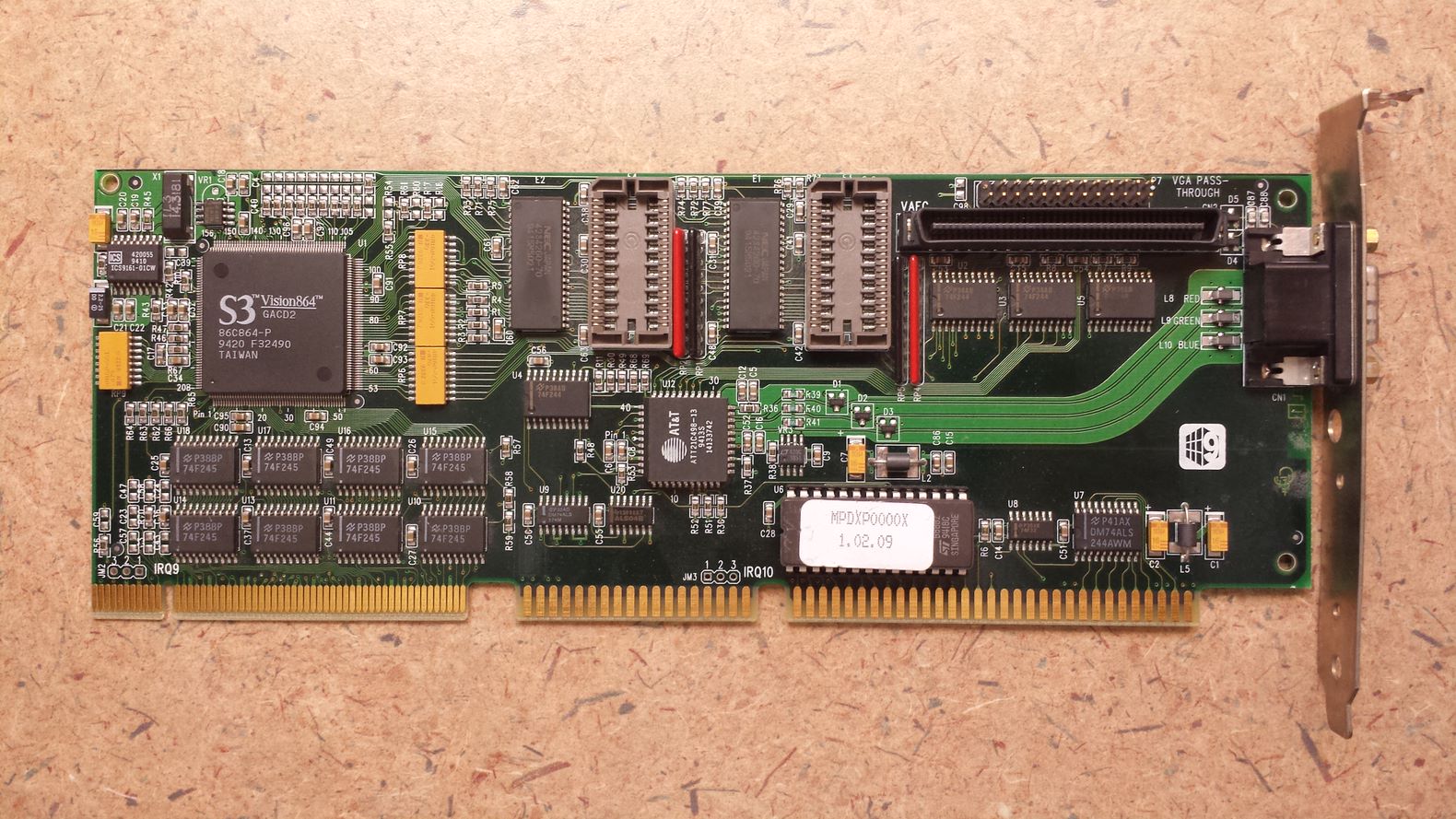 Vision864 Vision864
Launched: 1992
Bus: VESA Local Bus, PCI
Chipset: 86C864D (VLB) or 86C864P (PCI)
RAMDAC: ?
Memory: 512 KB, 1 MB?
Images courtesy of Vogons member, Artex.
Found on the following cards:
For drivers and utilities, go to the Downloads page.
More Images
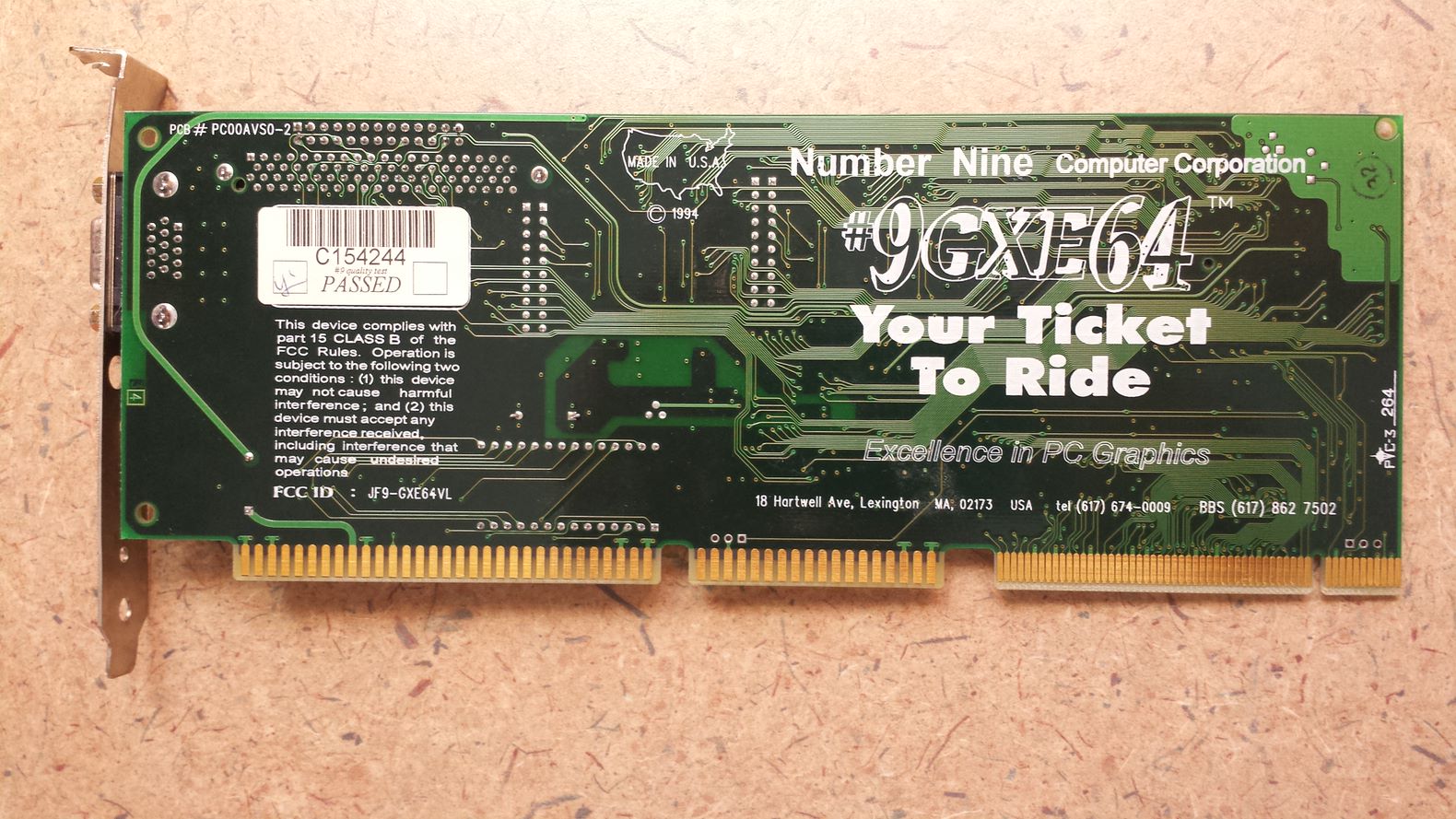
|
 86C801 86C801
Launched: 1993
Bus: ISA 16-bit
Memory: 1 MB or 2 MB
RAMDAC Speed: 80 MHz or 110 MHz
The 86C801C was a great-performing SVGA chipset on the ISA bus. It had a 32-bit internal architecture and supported a 32-bit path to display memory, as well as full support for True Color (16.7 million colours). It supposedly provides twice the VGA performance of the 86C924 in DOS (likely because the 86C924 only had a 16-bit data path to its memory).
It was first announced alongside the 86C805 and 86C928 in July 1992 (early sampling in August), with the 801 dedicated to the ISA bus, the 805 for EISA and MCA buses, and the 928 being the high-end one, offering resolutions up to 1600 x 1200 with 4 MB of VRAM.
The reference design required the use of 70ns DRAM memory chips as a minimum. Some video card manufacturers including Diamond, Metheus, Mirage, Nth, Orchid and VideoSeven opted to go for faster 60ns memory on their boards. Most '801 cards came with 1 MB onboard with the option to expand it to 2 MB (the maximum) later on.
In Windows, its performance pretty much matched the 86C928, but was slightly behind the ATI Mach32-based cards it competed with. Having said that, the 801 was considered 'fast Windows performance on a budget'. It also competed with the Cirrus Logic CL-GD5246.
"The S3 86C801, which is found on more boards in this review than any other chip, proved the price/performance leader. Boards sell for as low as $160 on the street, and this chip's Super VGA, 256-color test results in the 10- to 13-megapixel-per-second range sets it above its peers. [The 86C801-based boards] relying on cheaper DRAM to keep costs down.
Boards based on the S3 86C801 chip have matured to the point where they have overtaken the older
S3 86C924-based products, even though the latter have faster VRAM.
Affordable acceleration is what you get when you choose a graphics card based on the S3 86C801 accelerator. For no more than you might pay for last year's Super VGA frame-buffer board, you can buy speedy Windows performance complete with all the resolution you can squeeze out of most reasonably priced monitors. As little as $160 (street price) will give you a board that delivers a Graphics Winmark score of about 10 megapixels-per-second at 800-by-600 and 1,024-by-768 at 16 colors. And at these resolutions with 256 colors, some of the 86C801-based boards provide Winmark scores in the 11- to 13-megapixels-per-second range. You also get 1,280-by-1,024 capability at 16 colors with 1MB (or 256 colors with the optional 1MB most of these boards can support), and as many as 16.70 million colors at 640-by-480 resolution on-screen.
The virtues of the 86C801 accelerator include its 32-bit internal architecture (though it connects directly only to the 16-bit ISA bus), its 32-bit path to its display memory, and its support for true color. Additionally, the chip supports a 72-Hz refresh rate at 1,024-by-768 noninterlaced resolution. It manages 60 Hz in 1,280-by-1,024 noninterlaced and 43 Hz at 1,280-by-1,024 interlaced modes.
The 86C801-based boards turned in DOS speeds similar to - even a little faster than - the more costly 86C928-based boards, which hover in the $400 to $500 list price range (with 1MB). In the 86C928 and 86C801, S3 incorporates a dual-address bus for DOS text mode; the 86C801 adds a scheme to reduce wait states.
In all cases where a company supplied both a '928 and '801-based board, the '801-based board provided the faster DOS performance of the two." PC Magazine, April 1993
The chipset supported 72 Hz refresh rates at resolutions of 800x600 and lower, and a 70 or 72 Hz refresh rate at 1024x768.
Found on the following:
|
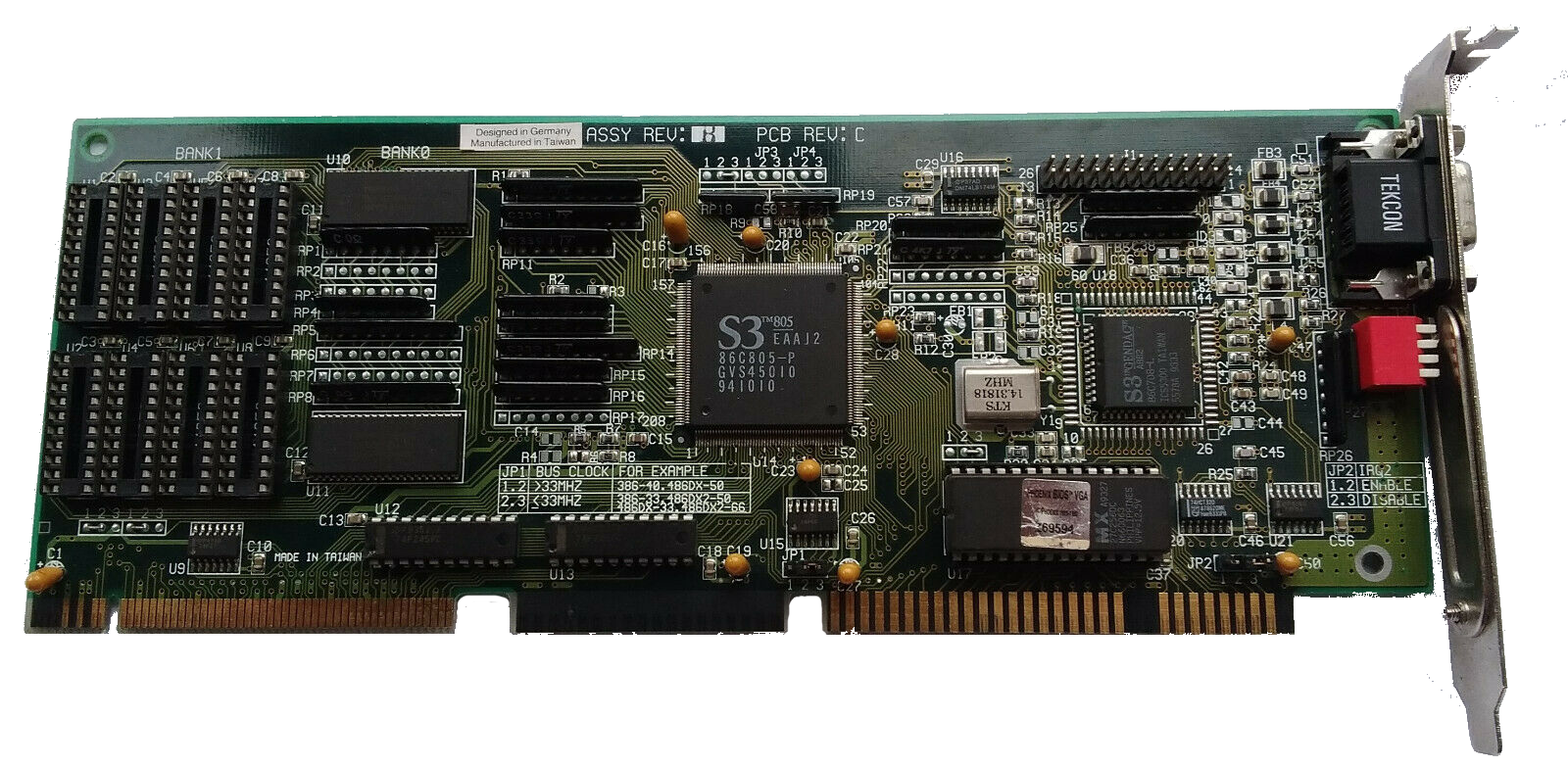 86C805 / 805i 86C805 / 805i
Launched: 1993
Bus: VESA Local Bus
Chipset: 86C805i
RAMDAC: Sierra STG1700J-13Z (32K/64K)
RAMDAC Speed: 135 MHz
Memory: 2 MB
VESA Standard: Yes, v1.2
FCC ID: -
BIOS Dates: 07/08/94
Known BIOS Versions: 1.02.01
The 86C805 was essentially the VESA Local Bus version of S3's 86C801 chipset. It supported up to 70ns DRAMs.
The 86C805i can be found on:
More Images
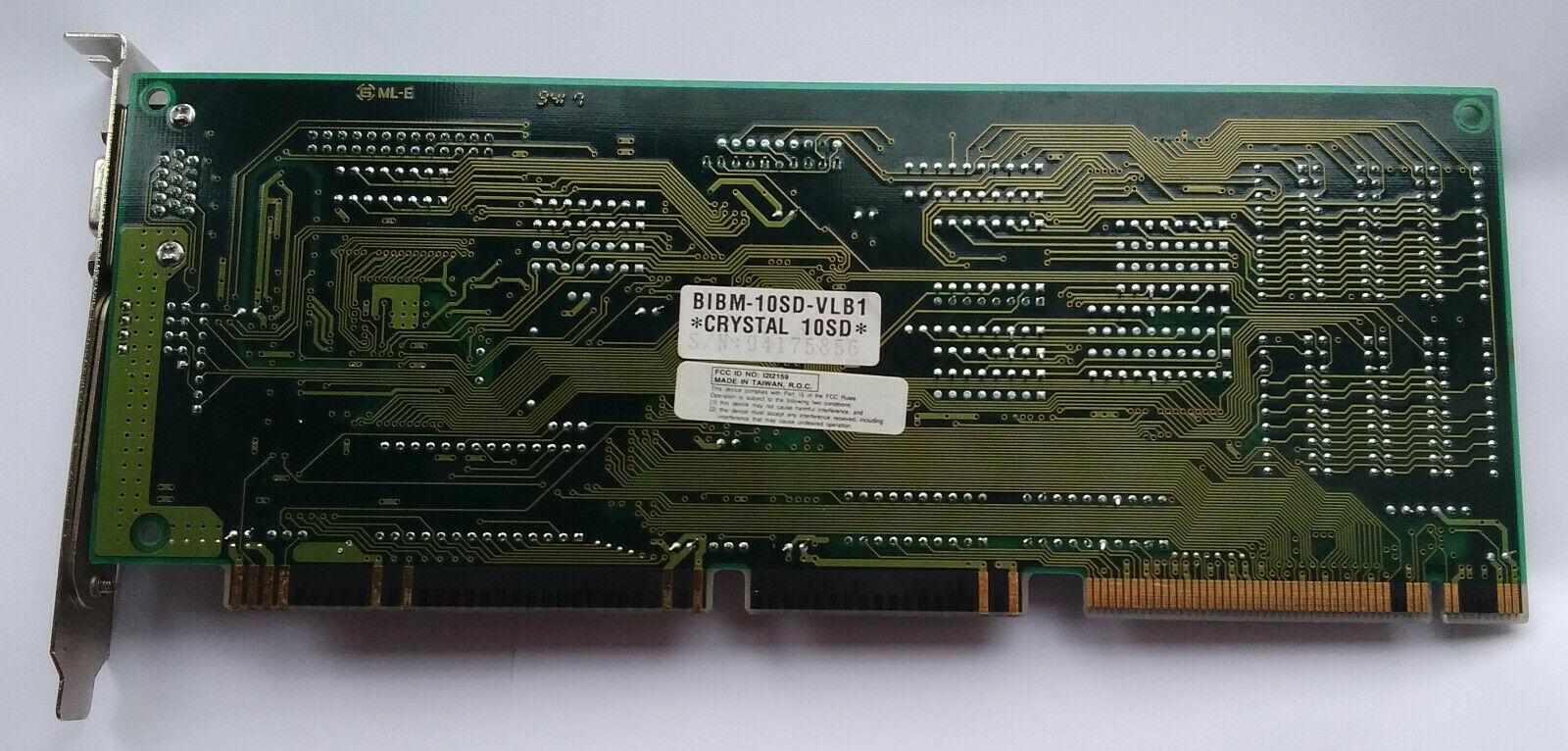 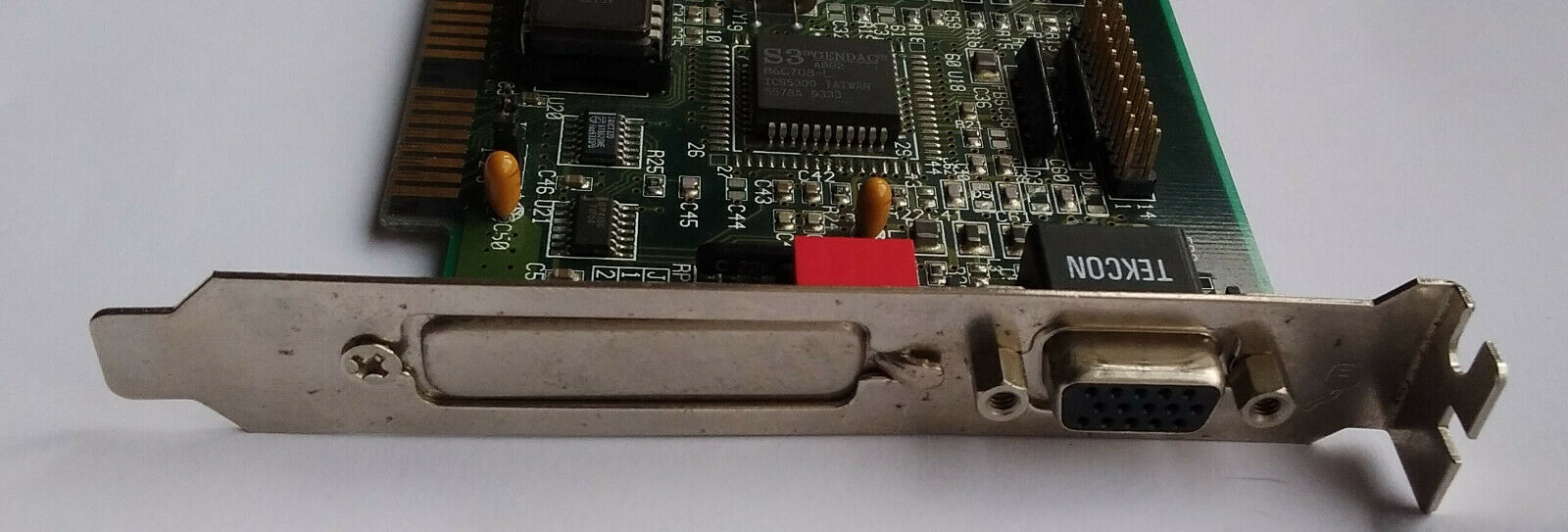 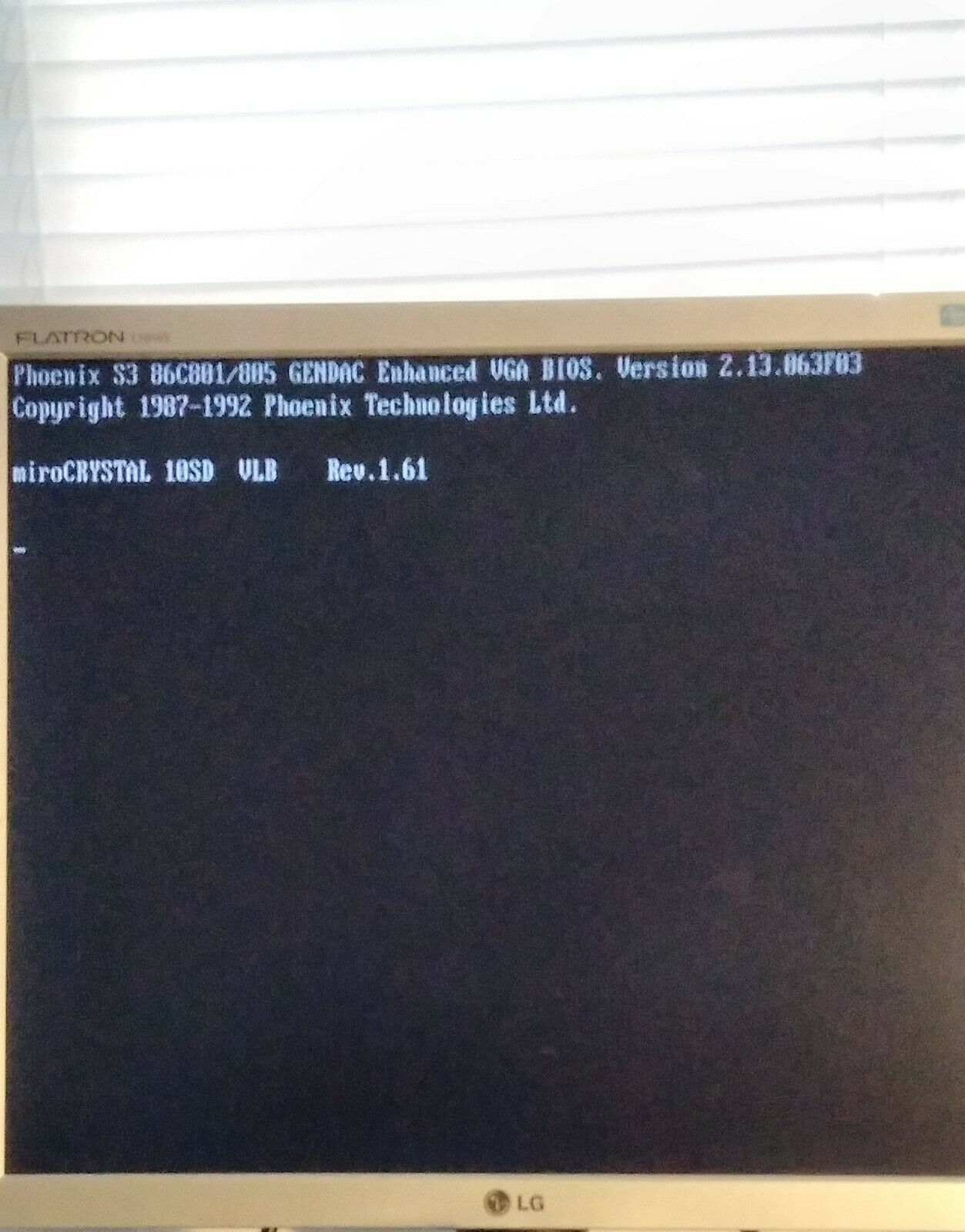
|
 Vision868 Vision868
Launched: 1994
Bus: PCI
Chipset: 86C868
RAMDAC: ?
Memory: 512 KB, 1 MB
Found on the following:
For drivers and utilities, go to the Downloads page. |
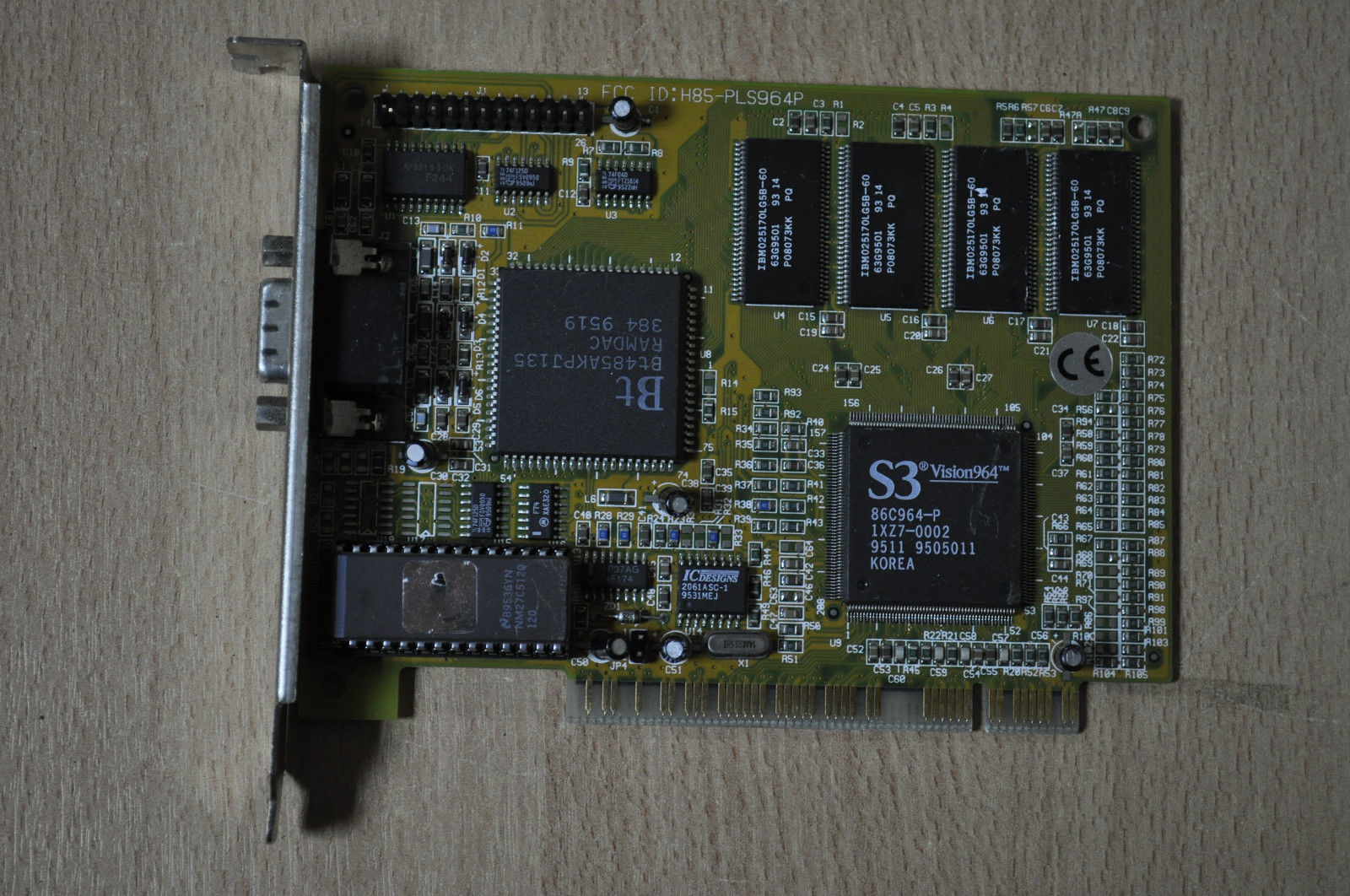 928 928
Launched: 1993
Bus: ISA, VESA Local Bus, and PCI
Chipset: 86C928D (ISA) or 86C928P (PCI)
RAMDAC: Brooktree 467, Brooktree 486, Diamond SS2410, AT&T C491, Sierra 15025CV
Memory: 1 MB, 2 MB or 4 MB
FCC ID: -
Considered to be a high-end Windows accelerator, but is a poor choice for DOS gaming, where its performance is lacklustre.
"S3 Corp's latest entry in the accelerator race is the S3 86C928. As a group, products based on this chip prove to be among the front-runners in the S3 product line. Indeed, in terms of Windows performance they have few competitors among all the reviewed boards that are based on other vendors' accelerator or coprocessed chips.
With a maximum of 4MB of VRAM, the fully VESA-compatible 86C928 chip offers true-color support for resolutions up to 1,024-by-768 and a maximum resolution of 1,600-by-1,200 noninterlaced at 16-bit color. With 1MB of VRAM, you can achieve 16.7 million colors in VGA mode, 64K colors in Super VGA mode, or 16 colors at 1,280-by-768. Another feature of the 32-bit chip is its linear address mapping for faster memory-to-screen operations. Its shared memory architecture will allow it to support hooks to a video coprocessor for full-motion video.
As a class, the S3 86C928-based boards distinguished themselves with fast Windows performance. Most of the boards managed scores of at least 13 megapixels per second in 256 colors. The ISA-based Number Nine #9GXE, however, topped them all with its score of 25.74 megapixels per second in 256-color Super VGA mode, but its driver cached text strings - a contraversial move." PC Magazine, April 1993
The Vision928 chipset can be found on the following cards:
For drivers and utilities, go to the Downloads page.
86C928 Datasheet |
 Vision964 Vision964
Launched: 1994
Bus: PCI / VESA Local Bus
Chipset: 86C964P
RAMDAC: Brooktree 485 or Texas Instruments 3020
Memory: 2 MB / 4 MB
FCC ID: H85-PLS964P
Maximum non-interlaced resolution 1600 x 1200. Max colours at this resolution = 65,536 (at 1024 x 768 the chipset supports 16.7 million colours).
Rebranded versions of the Vision964 were sold as:
For drivers and utilities, go to the Downloads page. |
_2.JPG) Vision968 Vision968
Launched: 1995
Bus: PCI / VESA Local Bus
Chipset: 86C968
RAMDAC: ?
Memory: 512 KB, 1 MB?
Images courtesy of Vogons member, Artex.
Found on the following:
More Images
.JPG) _3.JPG)
|
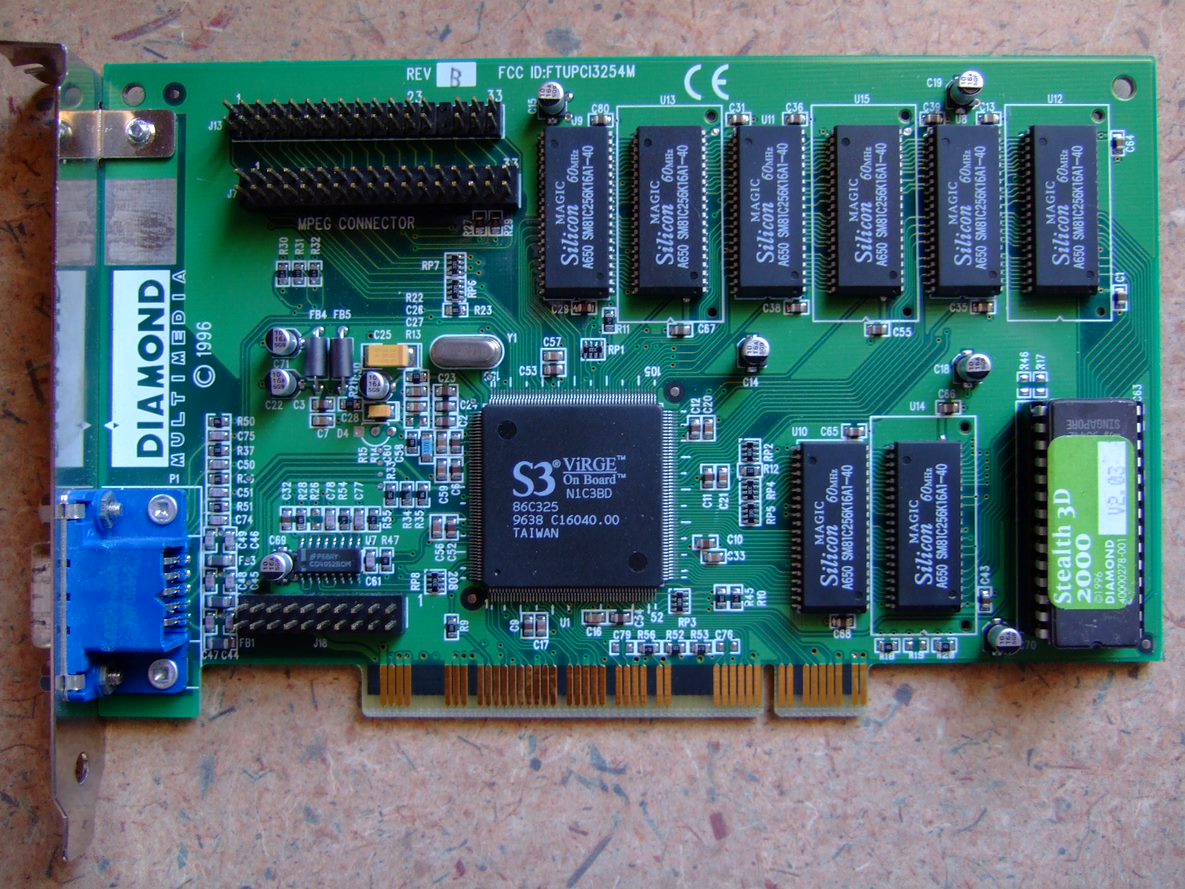 ViRGE ViRGE
Launched: 1995
Bus: PCI
Chipset: 86C325
Memory: 2 MB or 4 MB EDO
Ports: 15-pin DSUB
Images courtesy of Vogons member, Artex.
Key features:
- 55 MHz core clock
- 55 MHz memory clock (64-bit bus width)
- Runs the original S3 ViRGE chipset - the 86C325
- Memory can be expanded from 2 MB to 4 MB (giving a game ~14% performance improvement)
- 135 MHz RAMDAC
The ViRGE series introduced S3's "S3D" technology, which was supposed to be an API that game developers could specifically use to draw out the power of the ViRGE - unfortunately only about 20 games were ever written to take advantage of S3D. When Direct3D took off, API support for S3D was quickly dropped.
One advantage of the 86C325 is that it can be overlocked by 50% and still remains very cool.
Click here for a picture of a 2MB S3 ViRGE.
It was also sold by other manufacturers as:
Tip: To speed up DOS games, try the S3VBE20 and S3SPDUP utilities if the specific games support VBE 2.0 and/or are compatible with S3SPDUP.
Product Info Sheet (1998)
Datasheet
For drivers and utilities, go to the Downloads page.
More Images
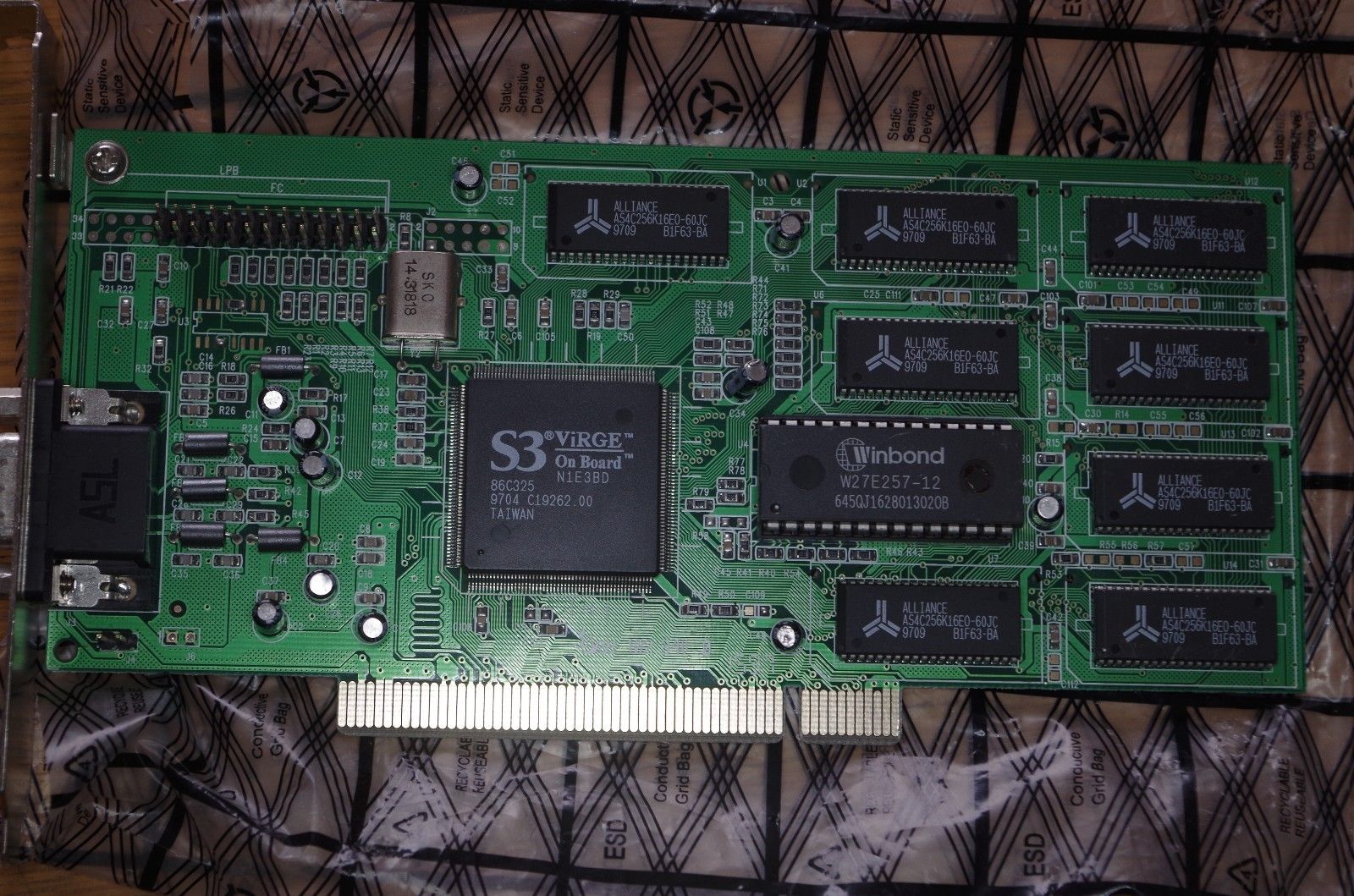
|
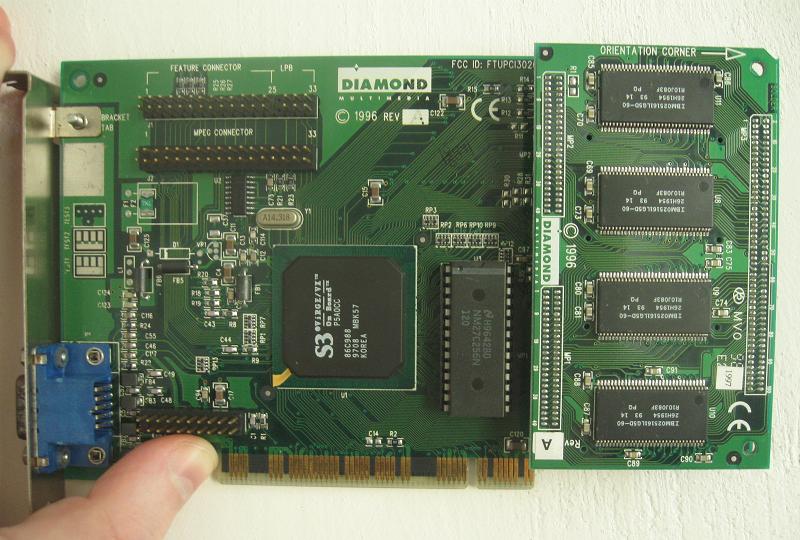 ViRGE/VX ViRGE/VX
Launched: 1996
Bus: PCI
Chipset: 86C988
Core Clock Speed: 52 MHz
Memory: 8 MB
Memory Speed: 52 MHz
The ViRGE/VX clocked its core at 52 MHz (lower than the original ViRGE), but the card got dual-ported RAM so was able to read from the frame buffer without preventing communication to the graphics chip. The ViRGE/VX on average runs approx 6% faster than the original ViRGE, so this is still a slow card. Still, in 1996, the ViRGE and ViRGE/VX made up about half of all 3D cards on the market.
Key features:
- 52 MHz core clock
- 8 MB 60ns memory as standard
- 52 MHz memory clock (dual-port RAM access)
- 220 MHz RAMDAC
It was also sold by other manufacturers as:
Tip: To speed up DOS games, try the S3VBE20 and S3SPDUP utilities if the specific games support VBE 2.0 and/or are compatible with S3SPDUP.
Product Info Sheet (1998)
For drivers and utilities, go to the Downloads page. |
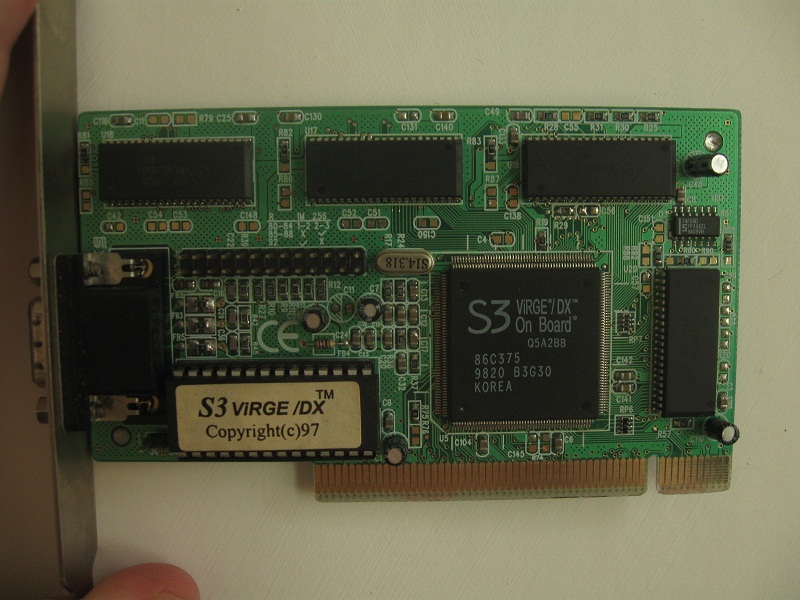 ViRGE/DX ViRGE/DX
Launched: 1997
Bus: PCI
Chipset: 86C375
Memory: 2 MB or 4 MB EDO RAM
Ports: 15-pin DSUB
The ViRGE/DX and ViRGE/GX was launched just one year after the first generation of ViRGE chips and cards. The DX is the budget one whilst the GX was almost identical but supported synchronous memory. Both cards are limited to 4 MB and both have a 170 MHz RAMDAC. However, S3 made significant updates to the 3D engine - perspective correction is separated so it no longer causes unncessary clocks on the pipeline, and they implemented a new texture filter which was able to sample from different mip-maps.
On average the DX is ~40% faster than an original ViRGE. Sadly, this is still not on par with other 3D cards available in 1997.
Key features:
- 55 MHz core clock (some 3rd-party versions run as low as 45 MHz)
- 4 MB EDO RAM
It was also sold by other manufacturers, some with empty memory sockets ready for expansion from 4 MB up to 8 MB, others with 8 MB soldered directly onto the board, and others again with sockets populated with memory. Here are some of them::
Tip: To speed up DOS games, try the S3VBE20 and S3SPDUP utilities if the specific games support VBE 2.0 and/or are compatible with S3SPDUP.
Tip: For Windows 98, use S3 drivers over the default ones that come with Windows.
Product Info Sheet (1998)
For drivers and utilities, go to the Downloads page. |
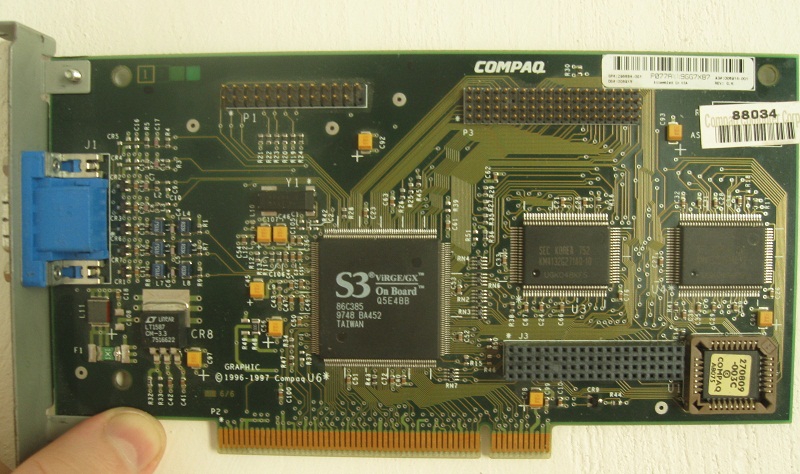 ViRGE/GX ViRGE/GX
Launched: 1997
Bus: AGP
Chipset: 86C385
Memory: 4 MB EDO RAM
The ViRGE/DX and ViRGE/GX was launched just one year after the first generation of ViRGE chips and cards. The DX is the budget one whilst the GX was almost identical but supported synchronous memory. Both cards are limited to 4 MB and both have a 170 MHz RAMDAC. However, S3 made significant updates to the 3D engine - perspection correction is separated so it no longer causes unncessary clocks on the pipeline, and they implemented a new texture filter which was able to sample from different mip-maps.
The GX has a small performance improvement (5-10%) on the ViRGE/DX. Sadly, this is still not on par with other 3D cards available in 1997.
The picture above is of an STB Systems-branded version, called Nitro 3D/GX.
Key features:
- 75 MHz core clock
- 4 MB EDO RAM - can use either SDRAM or EDO of same frequency
As with most ViRGE series cards, the GX was also OEM'd:
- Compaq OEM - no expansion module but gains through use of SGRAM
Tip: To speed up DOS games, try the S3VBE20 and S3SPDUP utilities if the specific games support VBE 2.0 and/or are compatible with S3SPDUP.
Product Info Sheet (1998)
For drivers and utilities, go to the Downloads page. |
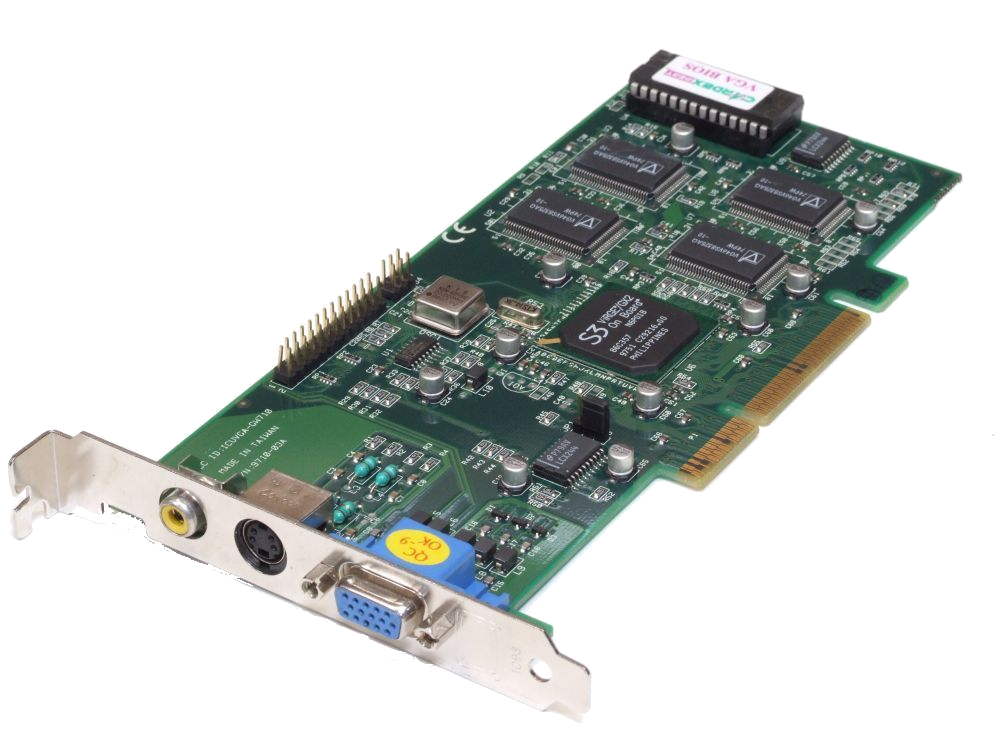 ViRGE/GX2 ViRGE/GX2
Launched: 1997
Bus: AGP
Memory: 4 MB
The GX2 was the successor to the ViRGE/GX.
Click here for another pic of the ViRGE GX2 .
Despite being their flagship product, poor software drivers and poor performance compared to the competition meant this card was a commercial failure. Similar performance to ATI's Rage IIc.
Key features:
- 0.35 micron technology
- 66 MHz core speed
- 99 MHz memory speed
- S-Video and RCA TV out ports
It was also sold by other vendors as:
Tip: To speed up DOS games, try the S3VBE20 and S3SPDUP utilities if the specific games support VBE 2.0 and/or are compatible with S3SPDUP.
For drivers and utilities, go to the Downloads page. |
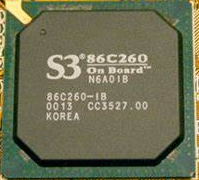 ViRGE/MX, ViRGE/MXi, ViRGE/MX+ ViRGE/MX, ViRGE/MXi, ViRGE/MX+
Launched: 1997
Bus: AGP 2x
Chipset: 86C260 (MX), 86C280 (MX+)
Memory: 2 MB (MX/MXi), 4 MB (MX+)
Ports: ?
Price: ?
The ViRGE MX chip was designed as a low-power version of the ViRGE/GX2. This was aimed at the mobile (laptop) market, although some MX chips found their way onto graphics card vendors' cards, presumably because it was a cheaper variant of the GX2 thanks to its lower clock speed.
Key features:
- 0.35 micron technology (8 million transistors)
- 135 MHz RAMDAC speed
- 55 MHz core speed
- 83 MHz memory speed
These chips tended to run a RAMDAC at 135 MHz, with a memory speed running at 83 MHz and the core at 55 MHz. Compared to the GX, an MX is approximately 11% faster.
The premium Toshiba Tecra 750DVD (1998) came with an embedded ViRGE/MX 3D graphics controller.
The MX was succeeded by the ViRGE/MXi which integrated 2 MB of 85 MHz DRAM into the chip for even greater power efficiency, and the ViRGE/MX+ which came with 4 MB of SGRAM.
For MX drivers, it's recommended to use a OEM Compaq driver v3009.
For drivers and utilities, go to the Downloads page. |
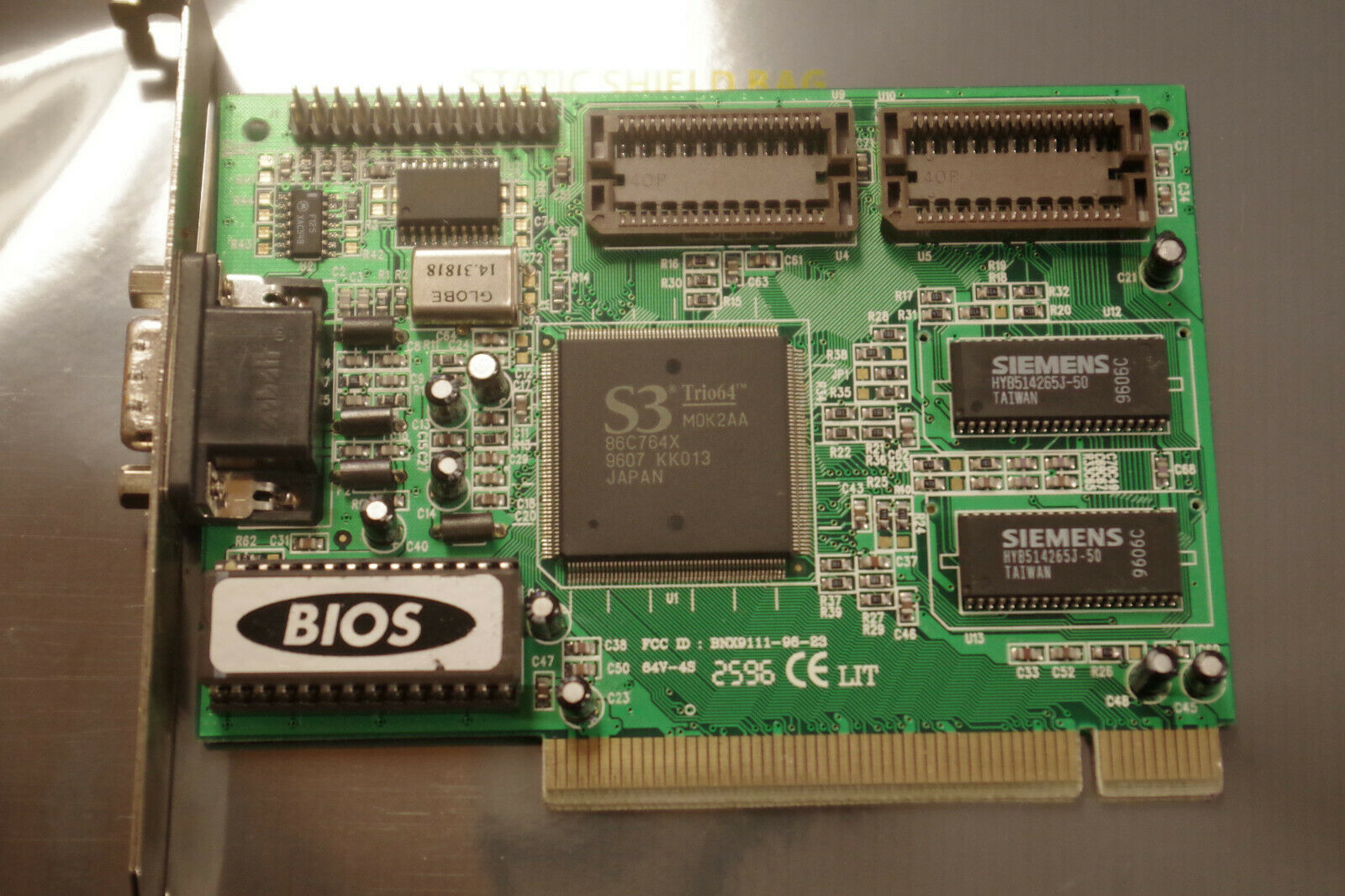 Trio 64 / Trio64 Trio 64 / Trio64
Launched: 1994
Bus: PCI, VLB, AGP 2x(?)
Memory: 1 MB or 2 MB
Core Clock: ?
The Trio 64 (or Trio64), also known as the S3 86C764, was S3's attempt to integrate a RAMDAC, clock generator and graphics core into their Vision864 chip. In 1994, it went up directly against ATI's fully 64-bit mach64 GX chip.
Trio64 can be found on these graphics cards:
Product Info Sheet (1998)
For drivers and utilities, go to the Downloads page. |
.jpg) Trio3D and Trio3D/2X Trio3D and Trio3D/2X
Launched: 1998 / 1999
Bus: AGP 2x
Chipset: 86C365 (Trio3D), 86C368 (Trio3D/2X)
Memory: 4 MB or 8 MB
Memory Clock: 100 MHz
Core Clock: 81.5 MHz
Following the last of their ViRGE-branded chips (the GX/2 and budget-oriented MX), in late 1997 S3 were stuck in a situation where they had no successor product that could be released. Continuing development off the back of ViRGE, they finally launched Trio3D in 1998. It added 128-bit memory addressing with support for 4 MB or 8 MB of SGRAM. The Memory clock on Trio3D was 100 MHz. 2D acceleration was improved over the outgoing GX/2 and MX, but on the 3D side there was little in the way of performance improvement, even though it catered for more 3D modes than earlier models. Due to the lateness of its arrival, it landed into a market that was already ahead of it, technologically. For this reason, S3 had no choice but to aim for the budget consumer market - what they lacked in performance they made up for with low cost.
The Trio3D/2X came out a year later in 1999, again with 4 MB or 8 MB RAM options, though it supported the faster SDRAM. The 2D acceleration was improved again from the Trio3D, and S3 managed to eek out better 3D performance, though it sits somewhere between the budget ViRGE/MX and its bigger brother the GX/2 of 2 years prior. Texturing in system memory is supported (and is 24-bit depth), leveraging AGP 2x's higher transfer rates. S3 also managed to rehash their drivers with Trio3D/2X with good compatibility.
Vogons member sliderider said this of the Trio 3D/2X: "The Trio3D was kept in production long past it's expiry date. You could still buy new cards or find it on motherboards even when you couldn't buy dedicated Savage cards anymore. I had a machine a long time ago with Trio3D video on board and I couldn't play a single game with it. They did 2D functions reasonably well, had a high degree of software compatibility, got along reasonably well with other hardware and were cheap, which is why OEMs kept buying them, but the 3D was worthless. Dedicated Trio cards are more a novelty than anything else. For games you're going to need a lot more power."
Vogons member muses "Trio 3d is Virge rebranded as business accelerator. It fixed the blending bugs of Virge. The 2x version has its own drivers and can do better in some geometry tests, so I think small improvements happened. Direct3d games are rendered more or less correctly, but it does not have the clocks of Virge GX2 and falls behind by 10-15%. At some point wirebond packaging limits memory interface speed, but I guess Trio 3D was about lowest price possible.
When judged by market share and longevity, the Virge was probably best 3d architecture ever. Suck it up performance enthusiasts."
Finally, Vogon user noshutdown' says this of the Trio 3D: "You are mostly correct, the Trio3D is based and improved on the design of S3 ViRGE. There are several versions of S3 ViRGE:
ViRGE: original "standard" version
ViRGE/VX: supports 8mb VRAM but slower clock, all other ViRGE supports only 4MB.
ViRGE/DX: improved and overclocked ViRGE
ViRGE/GX: based on DX but supports SDRAM/SGRAM
ViRGE GX/2: AGP version of GX
ViRGE/MX:
low power version of the GX/2
Trio3D: further improved on GX/2
As a result, Trio3D can run 3DMark01 while ViRGE can't. However, a third party OpenGL wrapper for ViRGE based on S3D can't run on Trio3D, guess its driver may have dropped S3D support and attempted to support D3D instead. ��
In general, i never considered S3 ViRGE or Trio3D as a real 3D card, as neither of them could support OpenGL. The Rendition 1000 is from the same year as s3virge but outperforms it by times."
Product Info Sheet (1998)
The Trio3D can be found on the following graphics cards:
The Trio3D/2X can be found on the following:
- ACorp ST-362A (see image above)
To download drivers for this card, go to the Downloads page. |
 Trio 32 / Trio32 Trio 32 / Trio32
Introduced: 1995
Bus: AGP
The Trio 32, as the name implies, is a cut-down version of the Trio 64, with a narrower 32-bit DRAM interface.
Unsure if S3 released a card of their own with this, but the Trio 32 chipset can be found on the Diamond Stealth SE graphics card.
Product Info Sheet (1998)
To download drivers for this card, go to the Downloads page.
|
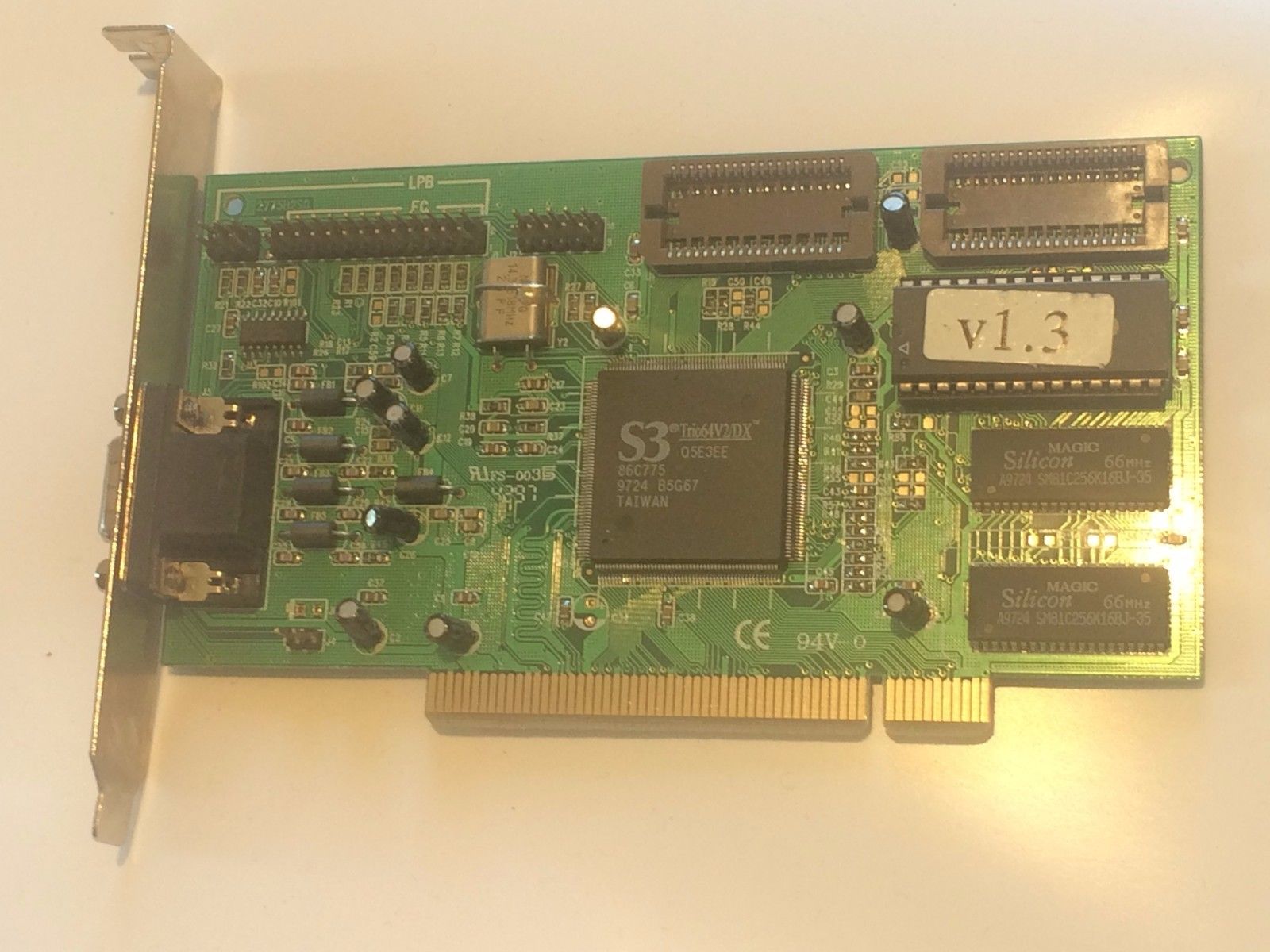 Trio 64 V2/DX Trio 64 V2/DX
Introduced: 1997
Bus: PCI
Chipset: 86C775
Memory: 2 MB or 4 MB
Price: ?
The Trio64V2/DX was essentially the same card as the ViRGE/DX, but used the 86C775 instead of the earlier 86C375.
S3's Trio was essentially their range of fully integrated solutions (with graphics core, RAMDAC and clock generator all on a single ASIC) based upon the earlier Vision 864 and Vision 868 accelerator chipsets. Like the 868, the 64V+ has a video acceleration engine that can perform YUV to RGB color space conversion and horizontal linear filtered scaling. Unlike the Vision964/968, the Trio chips do not support VRAM, and are limited to FPM DRAM and EDO DRAM only. The 2D graphics hardware was later used in the ViRGE.
The Trio64V2 improved on the 64V+ by including vertical bilinear filtering. The 2D graphics core was later used in the ViRGE/DX and ViRGE/GX. Like the corresponding ViRGE chips, the 64V2 also came in /DX and /GX variants, with the latter supporting more modern SDRAM or SGRAM. The final version, called the Trio3D, was effectively the 128-bit successor to the ViRGE/GX2.
The picture above is actually of a rebranded Trio 64 V2/DX, in this case a VideoLogic GrafixStar 410.
More Images
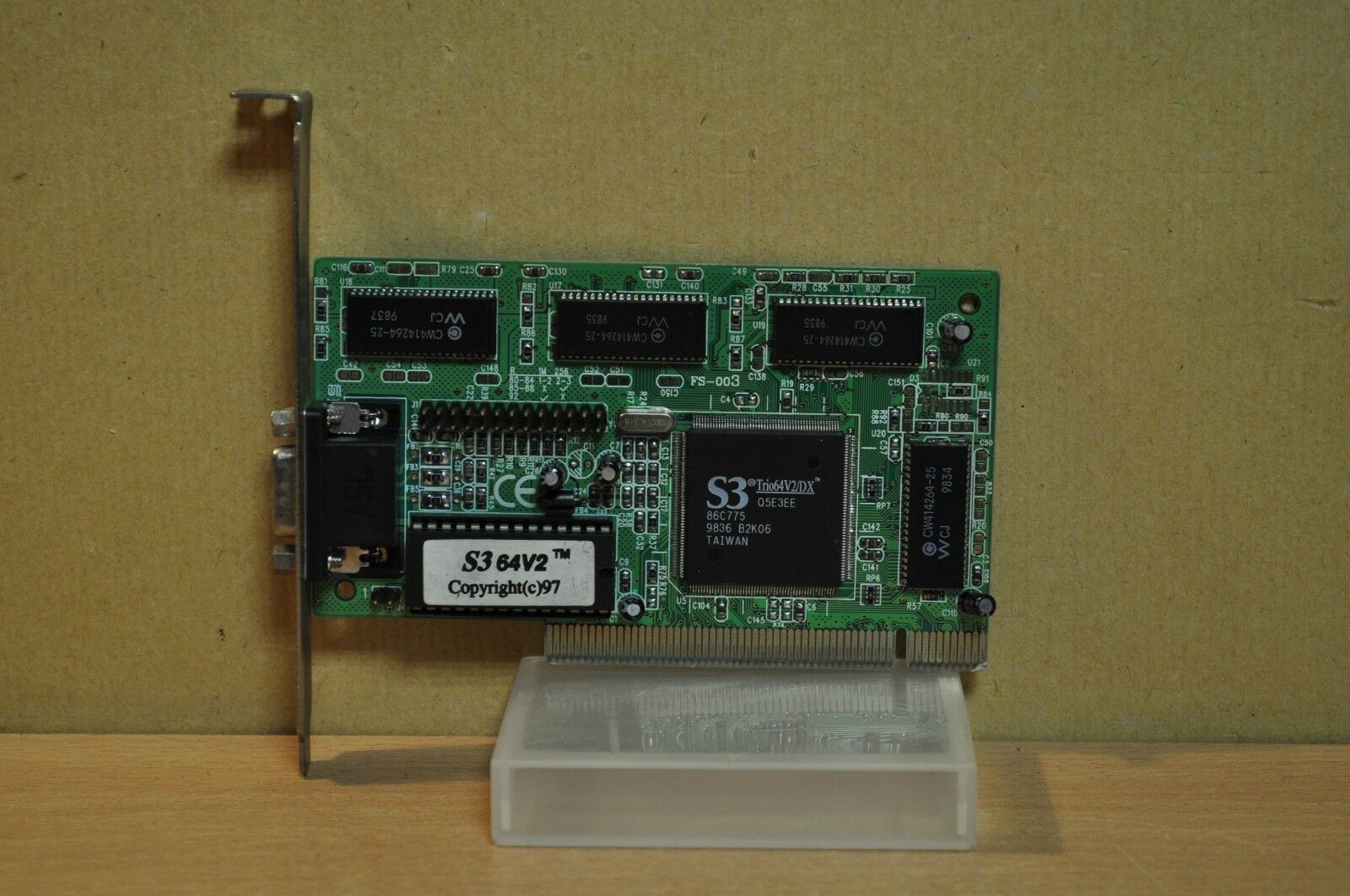 
Product Info Sheet (1998)
To download drivers for this card, go to the Downloads page. |
 Trio 64V+ Trio 64V+
Introduced: 1995
Chipset: 86C765
Bus: PCI
Memory: 1, 2 or 4 MB
Memory Package: 40-pin SOJ
Price: ?
The S3 64V+ was launched in 1995. Like the 868, the 64V+ has a video acceleration engine that can perform YUV to RGB color space conversion and horizontal linear filtered scaling. Trio chips do not support VRAM, and are limited to FPM DRAM and EDO DRAM only.
The Trio64V+ was found on:
Product Info Sheet (1998)
To download drivers for this card, go to the Downloads page. |
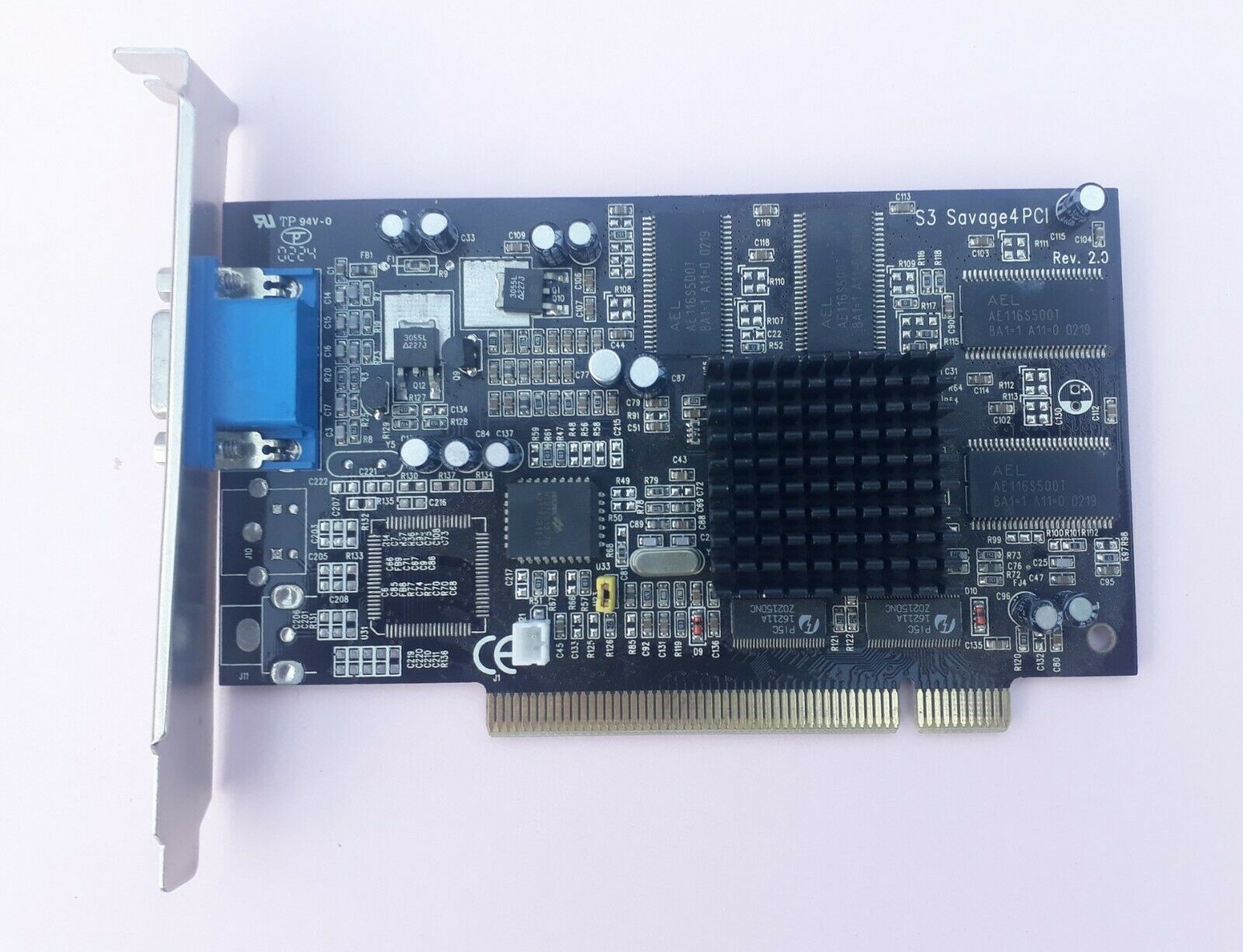 Savage4 / Savage4 Pro Savage4 / Savage4 Pro
Introduced: 1999
Memory: 8 MB (4, 4 LT), 32 MB (Pro)
Bus: PCI, AGP 4x
Core Clock: 143 MHz (Pro), 125 MHz (4), 110 MHz (4 LT)
Memory Speed: 125 MHz (non-LT), 110 MHz (LT)
RAMDAC Speed: Up to 300 MHz
Price: £79 ex.VAT (Diamond Stealth III S540, Dec 1999)
The Savage 4 LT ("Lite"?) was clocked lower than the standard Savage4, at 110 MHz for the core and memory. Most Savage4s are clocked at 125 MHz, and the Pro at 143 MHz. There was also an "Extreme" that got a core clock running at 165 MHz.
The Savage4 can be thought of as a bug-fixed Savage3D - good specs on paper, but turned out to be a commercial failure. Drivers were awful, but they did support OpenGL and Direct 3D.
There was also the Savage 4 Pro+ chipset, found on the Diamond Stealth III S540 card. This featured AGP 4x support (settable via some jumpers on the board), a 300 MHz RAMDAC and 32 MB of SDRAM. It was considered Diamond's budget offering at its launch in late 1999 (after Diamond's takeover of S3).
The Savage4 chipset was also used by the following cards:
- Creative 3D Blaster Savage4 - 32 MB SDRAM, 300 MHz RAMDAC (£59 ex.VAT, Dec 1999)
- Number Nine SR9 - 32 MB SDRAM, 300 MHz RAMDAC (£67 ex.VAT, Dec 1999) - see images below
"Creative's Savage4 is an entry-level budget option. While the Savage4 can't really compete with the other cards in the test, for just under £70 including VAT you wouldn't expect it to. Creative has opted for S3's Savage4 Pro along with 32 MB SDRAM and a 300MHz RAMDAC. ... In terms of performance, the Creative Savage4 came last in all of the 16bit colour Direct3D and OpenGL tests. Moving onto 32bit colour did not improve matters, with only those cards unable to perform in that colour depth doing worse. If you're into gaming, then you'll only be disappointed by this card, but as it is the cheapest in the tests you can't really expect tremendous performance. If you're not that interested in 32bit colour 3D then you could have a Voodoo3 2000 for £10 more." Personal Computer World, December 1999
More Images
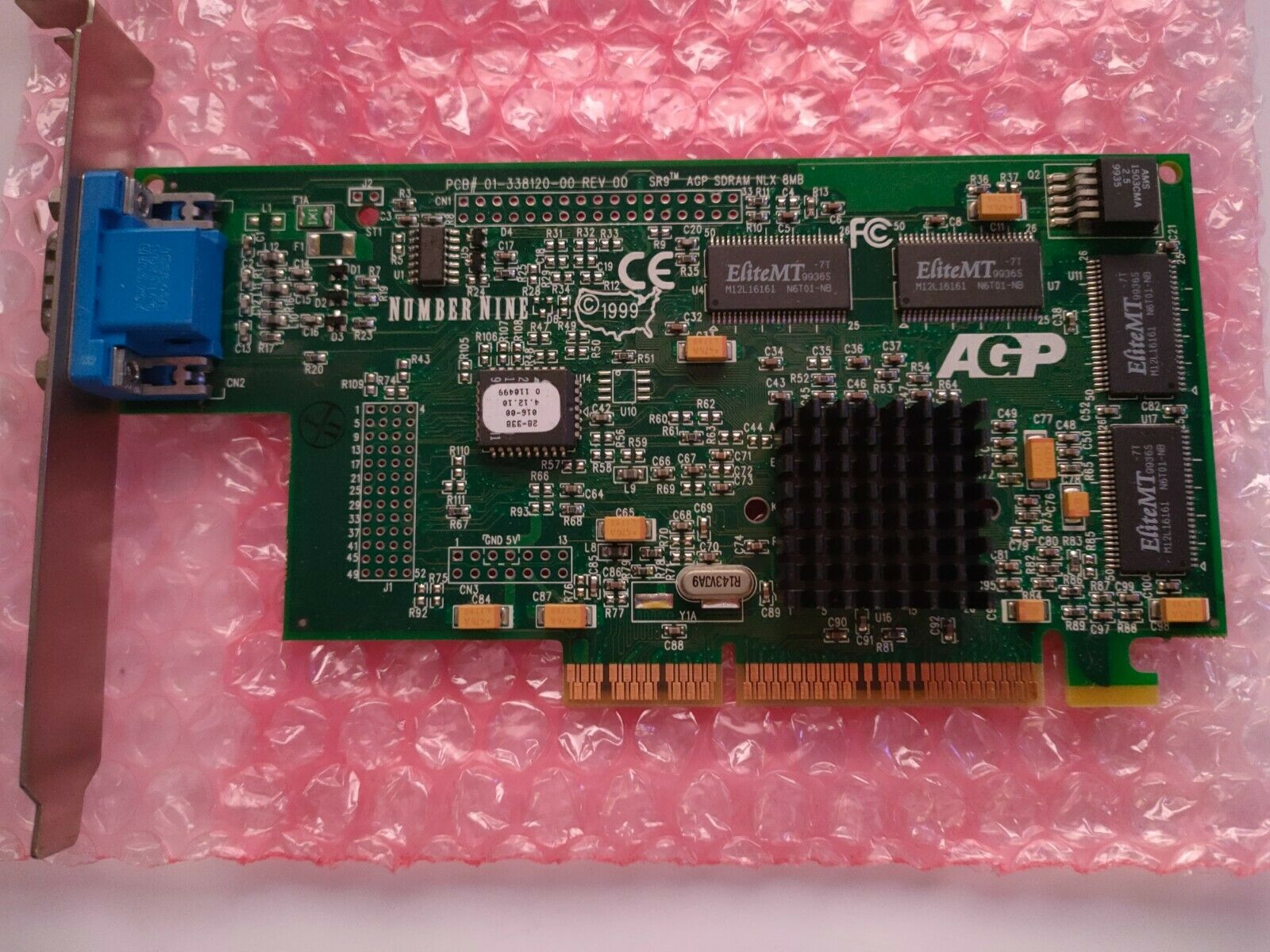 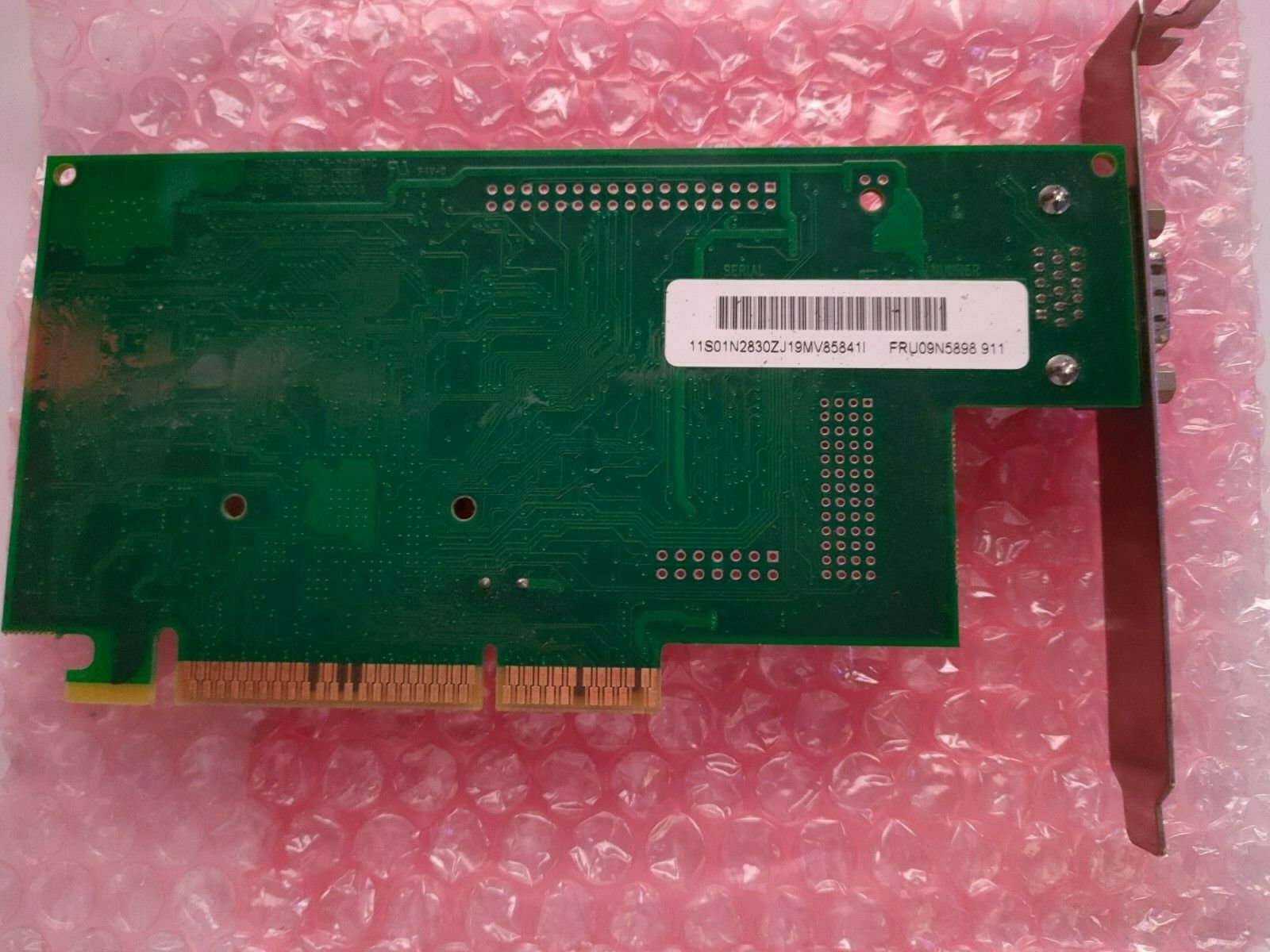 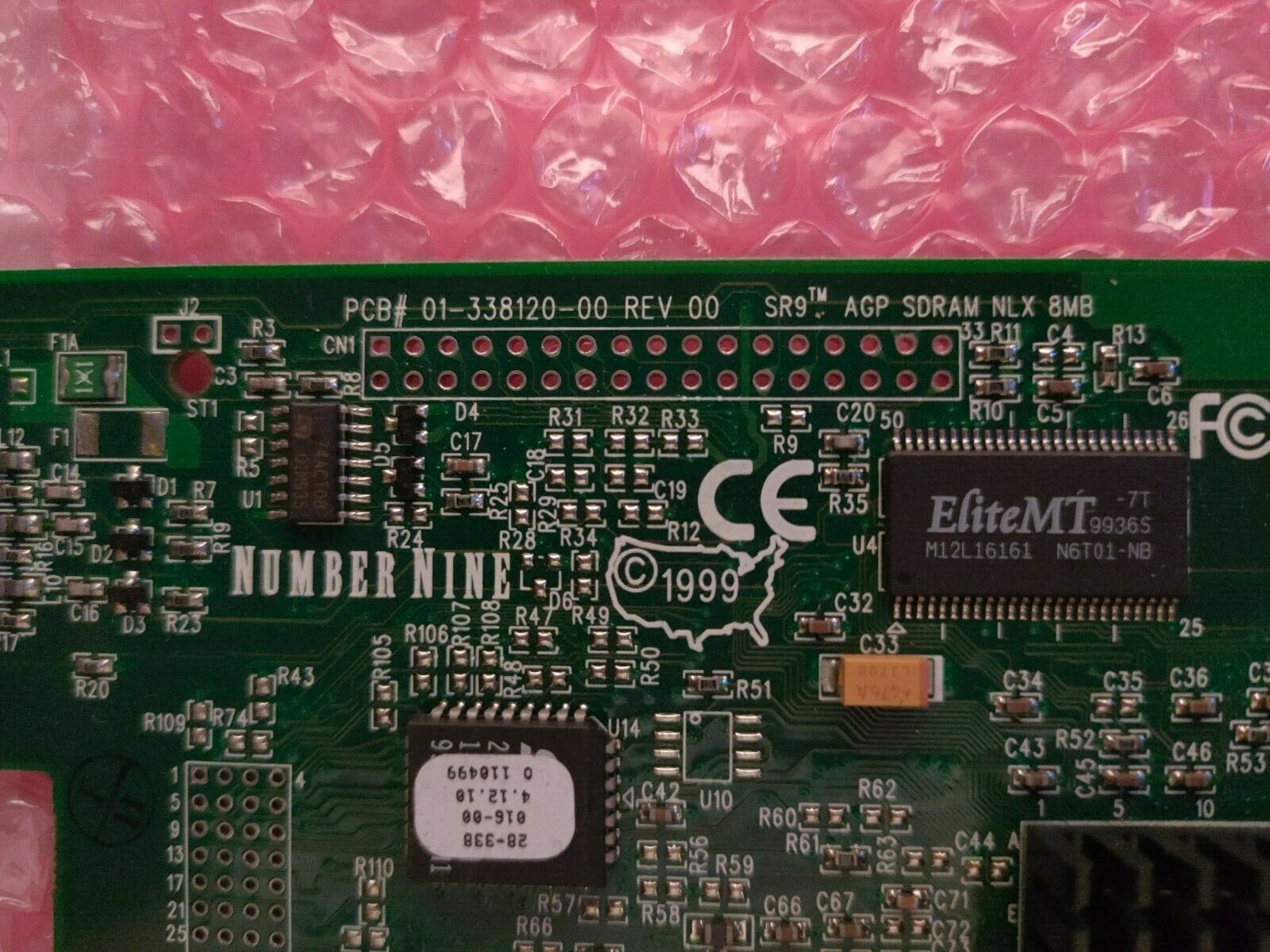
|
 Savage3D Savage3D
Introduced: Late 1998
Chipset: S3 Savage3D
Interface: AGP 2x
Memory: 2 MB, 4 MB or 8 MB SDR SGRAM
Memory Speed: 100 MHz
RAMDAC Speed:
Bus: AGP 2x
Price: ?
From S3's website in 1998, they say "S3 Attacks the Mainstream PC Market with the Industry's Highest Performing 3D Graphics Accelerator Targeted at the mainstream PC market, S3's Savage3D(TM) accelerator is a newly designed multimedia solution focused on setting a new standard for 2D, 3D and DVD/video acceleration. Delivering the industry's highest 3D quality and performance, the 128-bit Savage3D accelerator achieves an unprecedented 125 M-pixels per second through its single cycle trilinear architecture; and delivers more than 4x AGP performance through its newly designed AGP engine and Microsoft-endorsed texture compression technology."
It was designed to provide Voodoo 2 performance in 3D rendering for a much reduced price. In benchmark testing, Savage3D outperformed Voodoo 2, and scored almost the same as 3Dfx' other card, Voodoo Banshee. Initially, the Savage3D's drivers lacked support for triple-buffering, making early drivers perform at closer to double-buffering numbers.
Since Savage3D only has the one texturing unit, Voodoo 2 still does better when used with multi-texture fills. Furthermore, it does not fully make use of AGP 2x, with poor AGP transfer performance compared to Matrox G200 which makes full use of the AGP 2x greater bandwidth.
Key features:
- 125 MHz core clock - close to being overclocked (causes some triangle drawing errors at this speed)
The Savage3D chipset was also released on:
- STB Nitro 3200 - 100 MHz core clock
, 100 MHz memory clock
- Hercules Terminator Beast T9318SD - 100 MHz core clock, 100 MHz memory clock
- Hercules Terminator Beast T9328SG - 100 MHz core clock, 120 MHz memory clock
- BioStar Crux 390 - 106 MHz core clock, 106 MHz memory clock
- Number Nine Savage Reality 357 - 100 MHz core clock
, 100 MHz memory clock
- ViewTop Titan 5000 - 250 MHz RAMDAC, 125 MHz SDR memory (2 MB, 4 MB or 8 MB)
- DataExpert DSV5390
"Pros
Integrated Solution - The Savage3D offers both 2D and 3D acceleration with good 2D quality, but it's not up to snuff with the potential of the Matrox G200.
Good Performance - Running Direct3D games, the Savage3D chipset stays neck and neck with Voodoo 2.
Supposedly Free Trilinear Filtering - Triliner filtering should provide some hit on the 3D hardware, but early benchmarks show that enabling the feature results in no drop in framerates.
S3TC Texture Compression -
The same texture compression scheme Microsoft has licenced for DirectX 6.0, S3TC (6:1), is supported in hardware by the Savage3D. This should be useful for getting more texture variation if developers support the new DX6 API in their upcoming games.
Cons
No Multitexturing - Multitexturing support is a key component of Direct3D in DirectX 6.0 and is supported in most other emerging 3D technologies.
Too Expensive - S3 has traditionally dominated low-cost video solutions. Its first viable entry to the 3D world is priced quite high (products should cost between $150-$200).
On The Horizon
Future incarnations of the Savage3D will include support for features like anisotropic filtering, hardware bump mapping, shadows, full scene anti-aliasing, geometry and lighting setup, and more. Savage expects to release a new chip each year, so you won't see any of these features until the third quarter of '99." PC Accelerator, Issue 1 September 1998
Product Info Sheet (1998) |
Savage 2000
Having purchased Diamond Multimedia in 1999, the Savage 2000 was born. |









_2.JPG)
.JPG)
_3.JPG)








.jpg)







